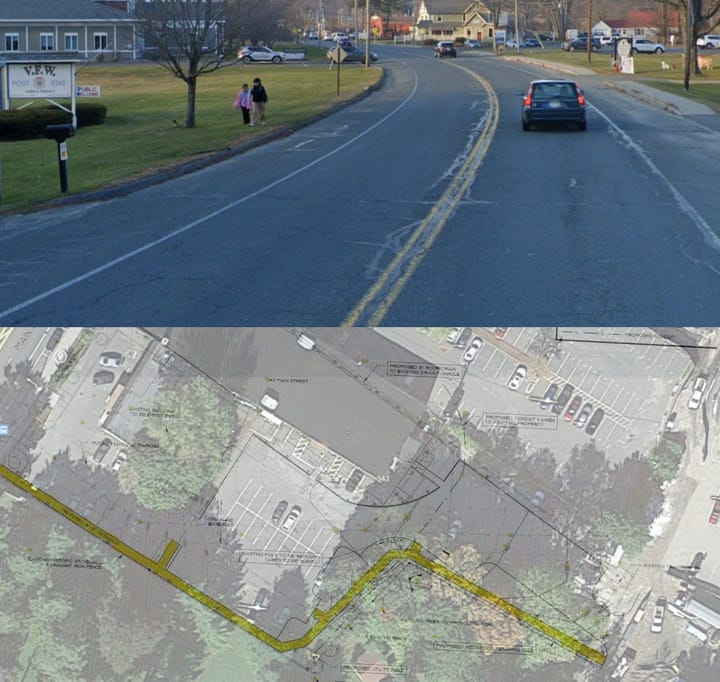The airport sits atop the only aquifer that supplies much of Great Barrington’s water. It's in a zoning district with strict water-protection rules. Is the town doing enough to monitor its activities?
∎ ∎ ∎
On a bitterly cold morning in late January, I stood ankle-deep in fresh snow at one of the higher spots in Great Barrington and took in the view. From a vantage point off Berkshire Heights Road, a small gap in maple and pine trees opened to a dazzling vista of Catamount to the southwest, just over the border in New York. The ski resort’s network of summit-to-base trails carved a familiar white pattern, even during the mildest winter in years.
Visible in the foreground were the open fields of the Walter J. Koladza Airport on Egremont Plain Road, its 2,579-foot paved runway cutting a dark line through the snow. The airport’s large maintenance hangar stood low but discernable in the flat light of an overcast day.
Behind me on that hill towered a weathered, 40-foot-tall, mottled gray, partially buried circular structure. Inside its 18-inch walls of pre-stressed concrete were 1.5 million gallons of water. Over the previous few days, much of it had been pushed more than 4,000 feet through a network of 12-inch pipes from a shallow well just off Hurlburt Road.
Calling a town’s water supply “a well” sounds like a mischaracterization. But given its importance to the wellbeing of this Berkshires community, it’s surprisingly modest. Technically, it’s a 225-foot-long concrete “infiltration gallery” that sits just 18 feet underground and roughly 200 feet from the edge of the Green River. For nearly a century, it has drawn clean water from a healthy, rapidly recharged aquifer that sits under sandy, permeable soils. That water has been used by generations of residents and visitors for drinking, bathing, dousing fires, and all the other uses of potable water in modern life.
From that unassuming spot near the town’s 88-acre McAllister Wildlife Refuge, the Green River heads south past agricultural and forested lands, making for a popular swimming hole off Route 23. On hot summer days, cars line either side of the road; barely dressed people walk a short trail to reach the water. Perhaps a handful know that for nearly two centuries, a mill powered by river flow at that location cleaned wool for textiles and ground flour for food.
In the other direction from the infiltration gallery, a mile-and-a-half of walking upstream along the riverbank would bring you to the airport’s property line. The Green River hugs the northern boundary of the airport, where it is intermittently shaded by brush and trees. A 2017 study of the river by the Housatonic Valley Association noted that stretch’s quick current and gravelly substrate. “And while mostly shallow, there are deep pools (in places five feet deep) created by downed trees,” the report said.
At the northeastern corner of the airport’s 90-acre property, which is owned by Berkshire Aviation Enterprises (BAE), the river makes a south-to-north S-turn before continuing toward Seekonk Cross Road. There it passes under a small bridge, makes a few twists and turns, and meanders past a rocky gravel bar and unofficial swimming hole. From there it turns sharply south and soon flows past the Great Barrington Fire District’s pumping station off Hurlburt Road. It’s a small building that sits a few dozen feet from the underground infiltration gallery.

If you jumped into any of the gallery’s three ground-level access doors and swam to the bottom, you’d find yourself inside a long, perforated concrete tube. To filter water entering from the aquifer, the holes are covered by layers of gravel, sand, and clay. And that’s all there is, really: Aquifer, infiltration gallery, suction tube, foot valve, collection tank, 100-horsepower pumps, and then water mains and storage tanks and customers’ taps and shower heads and spigots near backyard gardens.
Standing next to me and gazing up at the massive holding tank, which was built in 1985, was a New Marlborough man named Peter Marks. Easygoing, soon-to-turn 50 years old, and sporting a graying goatee, Marks has been an employee of the fire district for three decades. He’s served as its superintendent since 2003. I tagged along during his daily system-monitoring chores to view up close how Great Barrington gets its water—and the path that water takes to reach kitchen faucets, fire hydrants, hospitals, nursing homes, restaurants, churches, hotels, and those bottle-filling stations installed in 2019 after the environmentally minded town banned the sale of single-use plastic water bottles.
We had started not long after sunrise at Marks’ office at the fire district’s garage on East Street, visited the infiltration gallery and pumping station, and finally climbed that hill in a beefy fire district pickup truck to see the storage tank. On the other side of Great Barrington, off Blue Hill Road, there’s another one. It is shorter and wider but also holds 1.5 million gallons. The elevation of the water in each is precisely 1,023 feet; switching between them has no effect on the system’s water pressure.
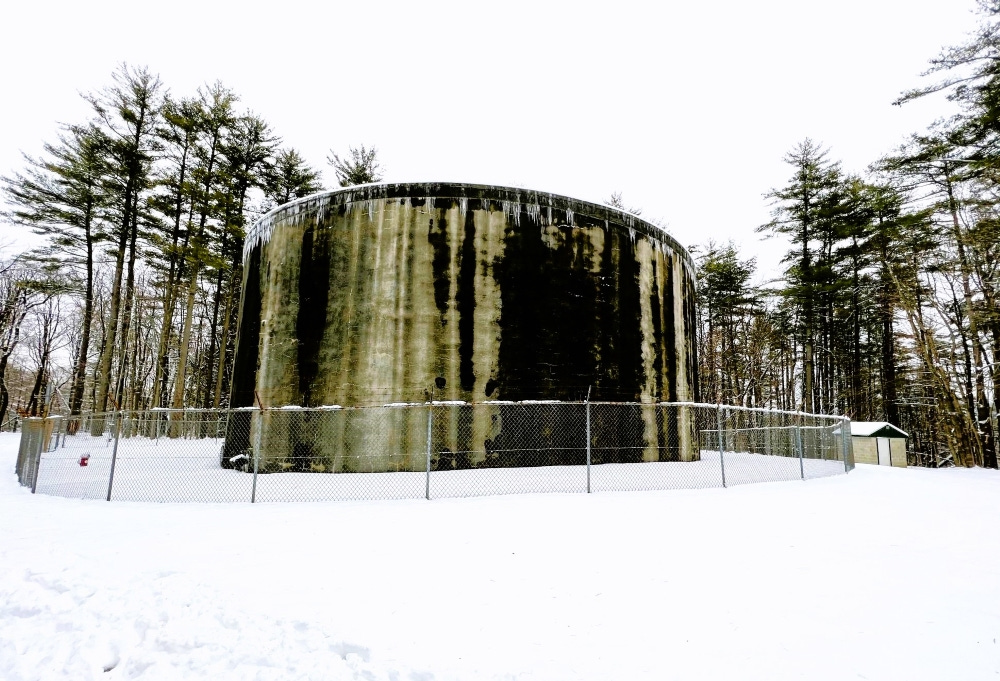
A framed, color-coded poster on the wall of the fire district’s reception area displays 42 miles of mains that transport water across town, the locations of more than 300 fire hydrants, and highlights where upgraded, modern pipes have been laid. New ones are made from ductile iron, Marks told me. They can last 100 years—perhaps twice that long in optimal soil conditions, he said.
Created before the Civil War, in 1854, the fire district had quite a few old pipes that needed replacement. Since Marks was hired, ongoing capital investment has upgraded many of them. “We’re always fixing and upgrading,” he said. That includes an ongoing program of leak detection using sensitive microphones that listen inside pipes for sounds characteristic of leaks. Together, those efforts have reduced water pumped each day by half-a-million gallons, even with more customers. The district has more than 1,700 connections; serves about 4,200 residents; and also delivers water to 224 commercial, industrial, and municipal locations, according to a 2021 state filing.
“We’ve done a couple of neighborhoods where the original [water main] is from the late 1800s,” Marks told me. “And within a couple of days of going full onto the new main, consumption’s gone down a couple of hundred thousand gallons.”

Each day an average of 500,000 gallons is pumped from the aquifer, through pipes, and into the storage tanks, variable by season from as few as 200,000 a day to as many as 800,000, Marks told me. Not surprisingly, usage peaks during hot weather from July through September. The day before my visit, Marks calculated that the system pumped a total of 578,000 gallons into the two tanks. More water is used on the East Mountain side of town than the homes and businesses served by the Berkshire Heights system, he said.
Marks has seen a lot during his 30-year career with the district. I asked him to explain—for the benefit of those who may not understand where their water comes from—the difference between the river and the aquifer. “There’s a massive flow underground that no one sees,” he said, describing the aquifer that feeds the system. He described the river as the “overburden” of that aquifer.
Still, the underground aquifer is not entirely distinct from the river. “It’s a groundwater source that’s classified as ‘under the influence of surface water,’” he explained. That means contamination in the river could impact water drawn from the well. But the state has never required testing that might clarify the extent of the river’s interaction with the aquifer near the infiltration gallery. He said that might be ordered if repeated incidents pointed to contamination that makes its way from the river into the drinking-water supply.
The airport’s sensitive location
The Great Barrington Airport sits directly atop the aquifer at the heart of that water supply. And that aquifer has long been the only source of water for more than half the town’s residents and all its downtown businesses, restaurants, and other venues critical to the region’s tourism-based economy. Whether or not the airport’s underground fuel storage and other activities might contaminate the aquifer—and if any risk is negligible, moderate, or potentially catastrophic—has been part of the community conversation here since BAE first appeared before the town’s five-member Selectboard in February 2017.
Back then, as they do now, the owners of the airport want their property recognized as a legally conforming aviation field under the town’s zoning bylaw, pending whatever conditions the board might attach to an enabling special permit. There’s more urgency now than in 2017 or when the Selectboard unanimously said no in 2020: A zoning-enforcement action that seeks to rein-in the airport’s level of activity—and therefore, some say, put it out of business—has been in front of a state Land Court judge since last May. (For a full exploration of the property’s zoning status and history, see parts one and two of this series.)
Even if the airport were located elsewhere in this town of 7,000, and not above its essential aquifer, there would be environmental concerns. The piston-engine, propeller-driven planes at the airport rely on aviation fuel with a toxic additive called tetraethyl lead, or TEL, which has been used since the 1920s to boost octane and improve engine performance. It’s among the few still-legal uses of lead in motor fuels in the United States: aside from piston aircraft, it’s only allowed in auto-racing, farm equipment, and marine engines. (Lead in automotive gasoline was phased out beginning in 1975 and completely by 1996.) And with significant health dangers from lead well understood and its use therefore sharply curtailed, the burning of leaded avgas today represents fully 70 percent of all atmospheric lead emissions in the United States each year.
Deciding not to formally endorse or oppose the airport’s latest application, the Great Barrington Board of Health last month asked the Selectboard to examine any danger and potential impacts from that lead in air, soil, and water. One of its members, local pediatrician Ruby Chang, later asked the Selectboard to require an independent environmental investigation. The airport did its own soil analysis in July 2017 and says that lead levels in the airport’s soil, after nearly a century of burning leaded fuel, are no greater than typical background levels. (BAE did not perform tests of atmospheric lead levels.)

Additional testing of the airport’s private drinking-water well, and years of lead-and-copper reports from the fire district, show no actionable levels of lead. Some airport abutters have claimed elevated lead in their water but have not demonstrated a definitive link to the airport. The airport’s attorney, Dennis Egan of Cohen Kinne Valicenti and Cook, told the health board that no further environmental testing is needed or planned.
The Board of Health’s concerns extend to the airport’s fuel storage. Throughout its 91-year history, the airport has stored up to 54,000 gallons of aviation fuel and other petroleum products in as many as six underground tanks, according to records maintained by the Massachusetts Department of Environmental Protection (MassDEP) and permits issued by the town. In recent decades, it stored 24,000 gallons of fuel in two single-walled steel tanks, and since 2018, a total of 20,000 gallons is held in one fiberglass, double-walled, monitored-and-alarmed underground storage tank (UST).
How safe is the town’s aquifer from that tank? And how safe was that water source over the last few generations? Federal and state regulations have imposed increasingly strict oversight of USTs, including frequent leak-testing by those that own and operate them. And ongoing compliance with those regulations is required to renew local fuel-storage permits and maintain insurance coverage that would pay for any cleanup and environmental remediation required because of leaks.
But decades of documents and correspondence obtained by the Argus via public-records requests—including some records that stretch back to the 1980s—reveal that until quite recently the airport’s record of compliance with regulations meant to protect the ground and water has been poor. For long stretches from at least 1998 to 2018 the airport routinely failed to properly conduct required monthly leak tests of its underground fuel tanks, maintain required records, install necessary equipment, meet mandated deadlines, and do other things required under state law to protect groundwater and the environment.
Despite numerous violations and periods of noncompliance documented by two state agencies and independent inspectors, additional records obtained by the Argus also show that municipal and elected officials in Great Barrington took no action in response to the airport’s years of repeated compliance failures. If they did, they made no public comment.
That’s surprising, considering how many planning documents, town policies, and zoning provisions have guided Great Barrington’s forward-looking approach to environmental issues and water quality for decades. Notably, that includes granting three municipal departments the specific authority, in 2006, to monitor the airport’s compliance with state UST-related regulations.
In other ways, it’s not surprising at all. As described in part two of this series, the airport has from its earliest days maintained a unique position in town. Established and initially owned by powerful local businessmen and elected leaders, the extent of its operations and its nonconforming zoning status have long been overlooked by town officials as the airport expanded its facilities and operations over generations—without ever seeking or acquiring a host of required permits and town approvals. That it was able to do what other businesses and property owners could not is made clear in drawers-full of town records and voluminous news coverage of other battles over zoning since the 1930s.
A groundwater-protection bylaw
That the airport—beloved by those who see it as a unique and valuable community resource—sits in a crucial location is well understood. For decades, town planners and state-environmental reports have specifically highlighted the substantial risks to Great Barrington’s vulnerable water supply. Master plans have focused on the town’s two essential water sources: the aquifer under the airport for the Great Barrington Fire District and Long Pond used by Housatonic Water Works—the long-troubled private water company that serves the northern, historically working-class section of town.
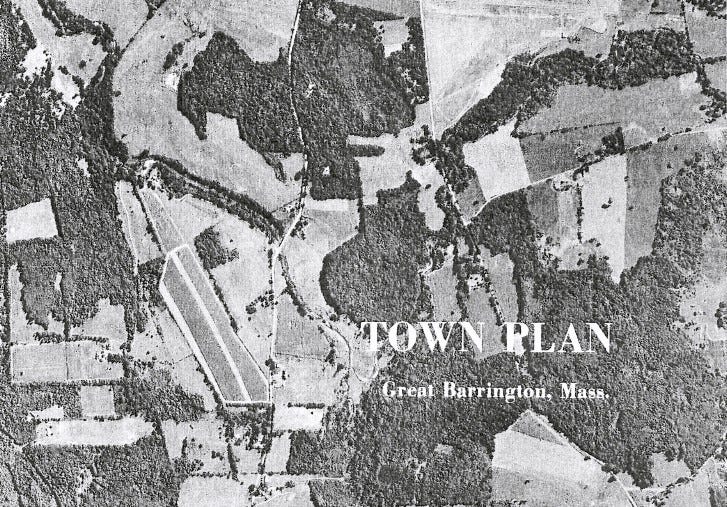
Great Barrington’s environmentally minded 1974 master plan called for new zoning provisions “to protect sensitive watershed and aquifer areas” and noted that “water does not respond to property boundaries … its misuse in one place affects its usability elsewhere.” Referring explicitly to the single water source used by the fire district, it warned, “Aquifers warrant special care, as the sources of their pollution are particularly insidious and their reclamation, once polluted, very difficult.”
The lack of an alternate drinking-water supply has been an ongoing concern. “If some contingency should interrupt the availability or quality of potable water from those sources,” officials wrote in the town’s 1987 master plan, “there is no backup.”
In 1996, Congress amended the Safe Drinking Water Act (SDWA) to require states to do more to protect their public water supplies from pollution. It called for creation in each state of a Source Water Assessment Program (SWAP). Seven years later, in 2003, Great Barrington worked in conjunction with MassDEP to produce a SWAP report for the fire district. It highlights many risks to the healthy aquifer that floods that Hurlburt Road infiltration gallery steadily and consistently. They range from farm runoff due to manure spreading and overuse of fertilizers and pesticides, to what at the time were at least a dozen petroleum-storing USTs, to the storage and use of other hazardous materials near the water supply.
It noted that less than one percent of land within the aquifer’s recharge area is devoted to commercial or industrial uses. Nearly all of that one percent is the airport; it was singled out as the most significant threat. “The airport is of the greatest concern in the Great Barrington Fire District Zone II, with a high potential for leaks of hazardous materials such as jet fuel.” (In addition to leaded avgas, at various times the airport stored 20,000 gallons of jet fuel underground for use by turboprop aircraft. Instead of reciprocating pistons, those use a variant of a jet engine to drive propellers.)
The SWAP report includes various warnings, helpful recommendations, and useful guidance on how to evaluate each threat. “It is important to understand that a release may never occur from the potential source of contamination provided facilities are using best management practices (BMPs),” the report said, repeating boilerplate language included in SWAP reports issued across the Commonwealth. “If BMPs are in place, the actual risk may be lower than the threat ranking … many potential sources of contamination are regulated at the federal, state, and/or local levels, to further reduce the risk.” Indeed, categories in which the airport’s activities are highlighted as high-risk note “improper handling or storage” as a reason.
Egan told the Selectboard last month that the SWAP report was written before installation of the airport’s upgraded double-walled UST in 2018. Therefore, he suggested, there is little environmental risk from underground fuel storage.
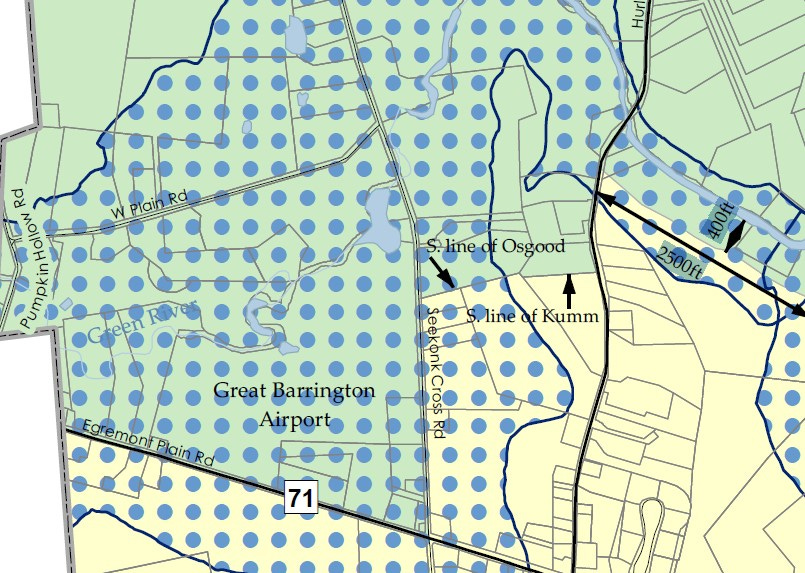
The SWAP report led to action. Three years later, at their May 2006 annual town meeting, Great Barrington voters approved groundwater-protection provisions known as the Water Quality Protection Overlay District (WQPOD). It’s a zoning designation that limits activities in sensitive areas connected to drinking water supplies and close to important water resources like rivers and streams. It prohibits a host of activities and puts strict limits on others, including the use, production, and storage of hazardous materials and waste. It banned underground storage of fuel unless already existing. The airport’s two USTs could remain and be upgraded only if replaced by tanks of the same size or smaller. Specific requirements for above-ground fuel storage were also adopted. The airport’s 90-acre property is entirely within the WQPOD.
The airport’s underground fuel storage
From December 1987 until January 2018, aviation fuel at the airport was held inside a steel, single-walled, 20,000-gallon UST. During that period, there was also a separate 4,000-gallon UST for automobile gasoline. Today the airport stores two flavors of aviation fuel, 100-octane leaded and 94-octane unleaded, in a two-compartment, fiberglass, double-walled, 20,000-gallon tank.
There has been local news reporting since 2017 that said USTs have to be replaced every 20 years, but that’s incorrect: BAE’s remaining two tanks were already 30 years old when they were removed. Others in use across Great Barrington, including at a fuel-oil company located for generations on Hurlburt Road, were far older: At least two of that facility’s 11 bare-steel single-walled tanks were installed in 1946.
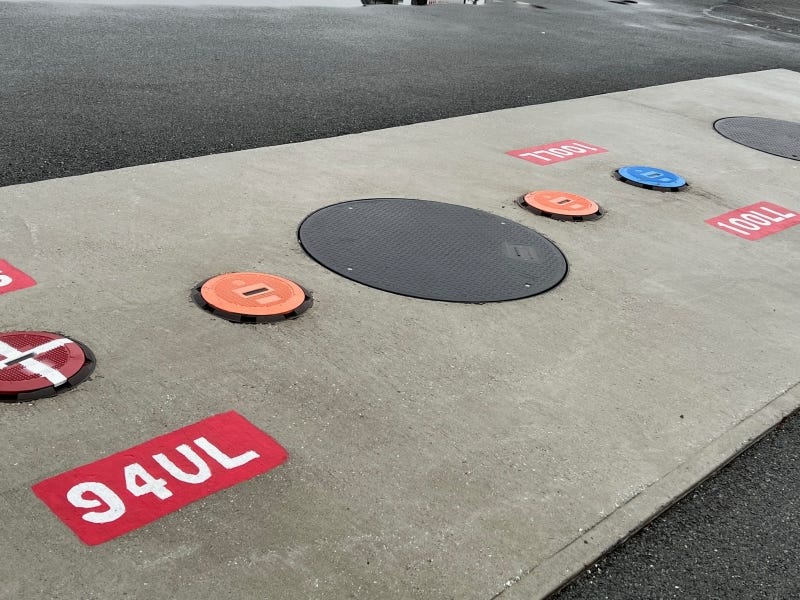
When the airport’s two remaining steel tanks were removed in 2018, they showed no evidence of leaks, according to reports filed by a state-certified licensed-site professional who monitored the project. He also tested soil samples from the cavities left by the tanks for evidence of petroleum and, according to his reports, found none. Eleven soil samples from where the larger tank sat for three decades showed no evidence of contamination. And the tank was reportedly in good shape. “The buffhide coating was intact, no areas of surface rust or corrosion were evident, and no holes were observed in the UST,” wrote William J. Fabbri, an inspector with WJF GeoConsultants, in a letter to the airport’s management.
In an email obtained by the Argus, Fire Chief Charles Burger updated then-Town Manager Jennifer Tabakin and Town Planner Chris Rembold on January 15, 2018. “The airport removed their existing [20,000-gallon] tank from the ground today,” Burger wrote. “The tank looked like it was new. It was actually fiberglass-wrapped, and the piping was double walled and went to containment, so the odds of the existing system leaking was about zero.”
That was no doubt a relief to the airport’s owners and to a community that relies on water from the aquifer that flows underneath the tank. According to the Environmental Protection Agency (EPA), over the last 40 years, hundreds of thousands of USTs have leaked and created contamination, expensive environmental cleanups and remediation, and damage to drinking-water aquifers.
Regulatory agencies have long focused on risks from USTs. In the 1980s, the EPA began to establish UST guidelines and pushed states to do more to address leaking tanks. Public awareness grew in part thanks to a December 1983 report on CBS’s “60 Minutes” that called leaking tanks “a ticking time bomb.”
According to Gordon Bullard, a longtime UST regulator who is the executive director of the Massachusetts Department of Revenue’s Petroleum Product Cleanup Fund, prior to 1988 not much was done.
“There was no real standard for regulating underground storage tanks [for] construction, operation, and maintenance,” he told me recently. At the time, 40 percent of Americans relied on groundwater for their drinking water, he said. So, beginning in 1988, he said that new regulations were implemented, including a ban on new installations of single-walled tanks in Massachusetts. Safer—and more expensive—double-walled tanks were mandated. (At the Great Barrington Airport, two single-walled steel tanks were installed in December 1987, just prior to the deadline.)
With new state and federal action, by the mid-1990s the number of UST releases leveled off and began to trend downward. According to EPA data, since 1984, nearly 570,000 UST releases have been identified and 509,000 have been cleaned up. With increased awareness of their environmental risks, the total number of underground storage tanks has declined from 2.1 million in 1984 to 540,700 today. State environmental data reported to EPA shows that UST releases of petroleum products are, by far, the top reason for groundwater contamination in the United States.
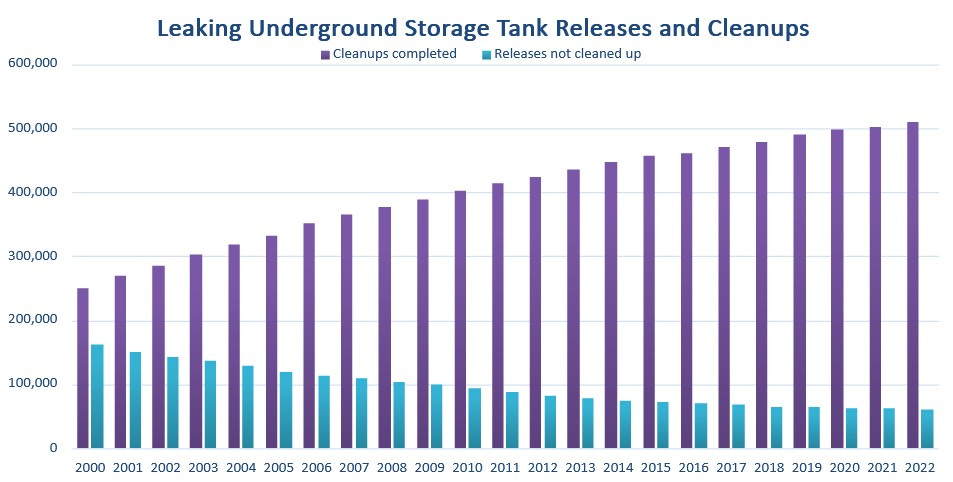
In 2009, the Massachusetts legislature moved most oversight of USTs to MassDEP to help meet new regulations established by Congress in 2005. And when the agency spot-checked UST facilities from 2009 to 2012, it found compliance with the requirement to have release- and corrosion-prevention equipment in place was more than 80 percent, about the national average. But the rate of compliance—using that equipment properly or at all—was poor and declining, falling to just 33 percent in 201 compared to 79 percent nationally. At the time, Massachusetts ranked dead last in the United States for UST compliance with federal standards.
“Before EPA and the Commonwealth adopted requirements for leak detection, releases were primarily discovered when an Owner or Operator realized that a significant amount of product in a tank was missing,” the MassDEP document said. “The existing regulatory requirements have not been sufficient to prevent USTs from leaking and from posing significant risks to public health and the environment,” the agency concluded.
Great Barrington has seen its own serious issues with leaking underground tanks, notably at the former Carpenter’s Variety (a.k.a. Whittaker’s gas station) on Main Street, directly across from Town Hall. At that location, gasoline from leaking USTs flooded into the soil and groundwater. It was discovered in 1986 by an electrician who smelled gasoline while working inside Searles Castle—hundreds of feet away. The gas station owner, William Whittaker, insisted any leak was small. “When we put 4,000 gallons in, we took 4,000 gallons out,” he told the Berkshire Eagle at the time. He described using a daily log to keep track of inventory. “We would have known if we were losing a lot of gas,” he said, incorrectly.
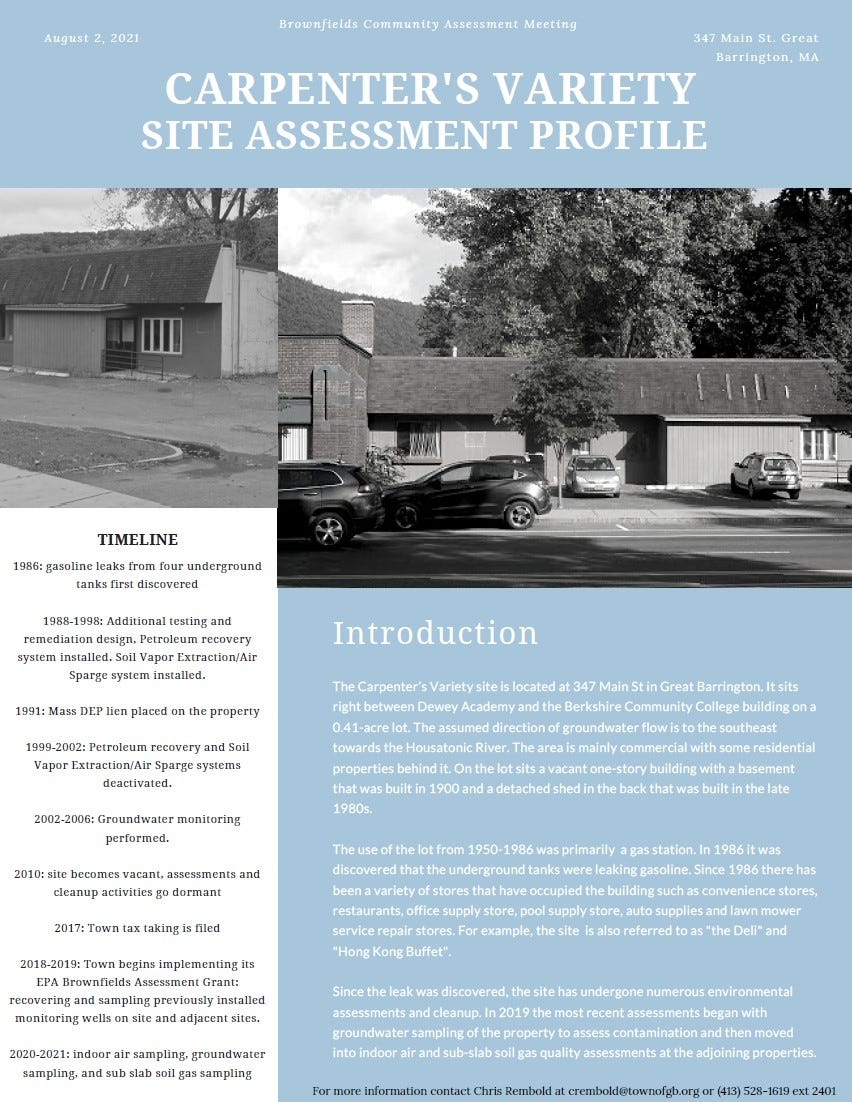
The discovery led to a decades-long cleanup. For years, that meant running a double-pump recovery system that drew up contaminated groundwater, removed the gasoline, and returned cleansed water back into the ground. Nearly 40 years later, additional remediation is still needed.
In Massachusetts, UST regulations have become ever-stricter, culminating in a 2008 mandate to close-in-place or remove all remaining single-walled USTs by August 7, 2017. The airport missed that deadline. For many years, the Commonwealth had already required that all new UST installations be double-walled tanks with more safety features. The airport’s current double-walled tank is outfitted with what’s known as interstitial monitoring: If fuel leaks from the inner tank into the space between the two walls, the system is configured to sound an audible alarm.
According to preliminary data provided to the Argus by MassDEP, from 2018 to 2022 there were nearly 200 reportable releases from UST systems, which includes tanks, piping, and dispensers. More than 25 percent involved double-walled systems. Releases came in many cases from older systems, highlighting the need for vigilant monitoring and testing as UST components age.
A poor record of compliance
Even during Selectboard hearings in 2017 and 2020, when environmental risks from the airport were discussed at length, there’s no evidence that board members sought or reviewed any UST compliance records. Nor did the Planning Board or Board of Health when they considered all three of the airport’s special-permit applications, including the one they considered just weeks ago that’s now pending before the Selectboard.
To remain in compliance with state laws, which are gathered under MassDEP’s Underground Storage Tank Program and the 107 pages of 310 CMR 80, UST facilities must consistently meet a host of requirements. That includes regularly testing their tanks and associated piping and pumps for leaks, monitoring corrosion protection and tank-gauging equipment, and maintaining detailed records of fuel inventory and of their regular system checks. Staff must have UST operator training and be certified by the state. Additional requirements were added last fall to require inspections and testing of even more UST system components.
According to records obtained by the Argus from multiple state agencies, at least as early as 1999, inspections by regulatory agencies and third-party inspectors repeatedly found that the airport failed to meet many of its compliance obligations—particularly when it came to required UST leak testing.
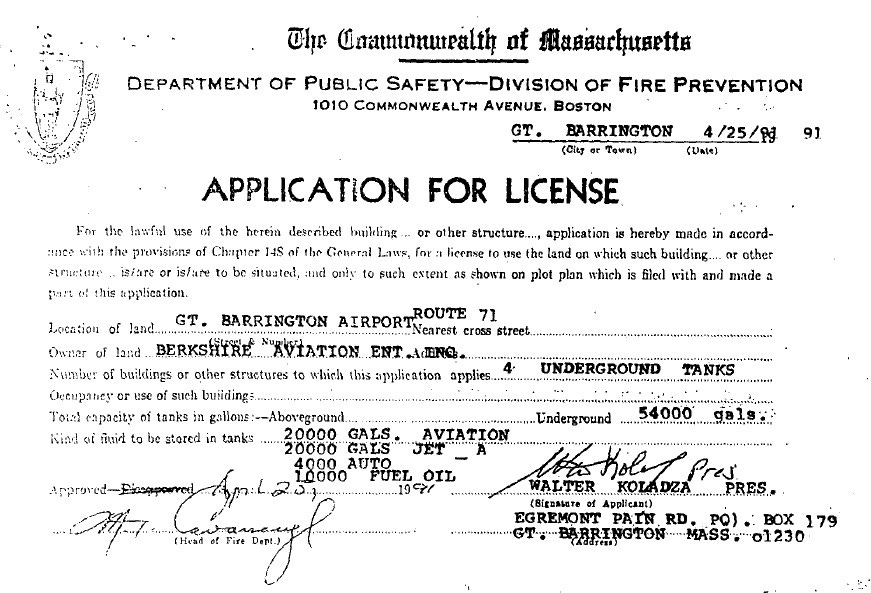
In January 1999, the airport’s two USTs appeared on a “Non-Compliant Tank Enforcement Report” from the state Department of Fire Services (DFS). According to Matthew Murray, a former firefighter and longtime DFS regulator, who is today the agency’s code compliance and enforcement supervisor, it’s likely the airport missed a December 22, 1998, deadline, announced 10 years earlier, to add required UST protection equipment. (The EPA published a booklet, “Don’t Wait Until 1998,” explaining the new requirements.)
Based on the DFS report, the airport likely failed to install proper pipe-leak protection, Murray told me. By the 1998 deadline, it was supposed to add leak detection, corrosion protection, and spill and overfill containment equipment. (A month later, the deficiencies were corrected.)
In November 2004, shortly after Koladza’s death, a DFS inspector found the airport in violation of six regulatory requirements. They included “failure to install, calibrate, operate or maintain leak detection equipment”; “failure to maintain cathodic protection for a steel tank”; “failure to maintain on-site an accurate and legible dipstick gauging device,” and “failure to demonstrate financial responsibility requirements in the event of an accidental release.”
The inspector’s entries into a DFS computer system obtained by the Argus via a public-records request showed the airport was not “in significant operational compliance with 1998 UST spill, overflow, and corrosion protection regulations” nearly six years after those requirements took effect. That database record also reveals that the airport was not conducting annual maintenance of tank-gauging features, did not test its line-leak detection system, and was not reconciling its fuel-inventory records.
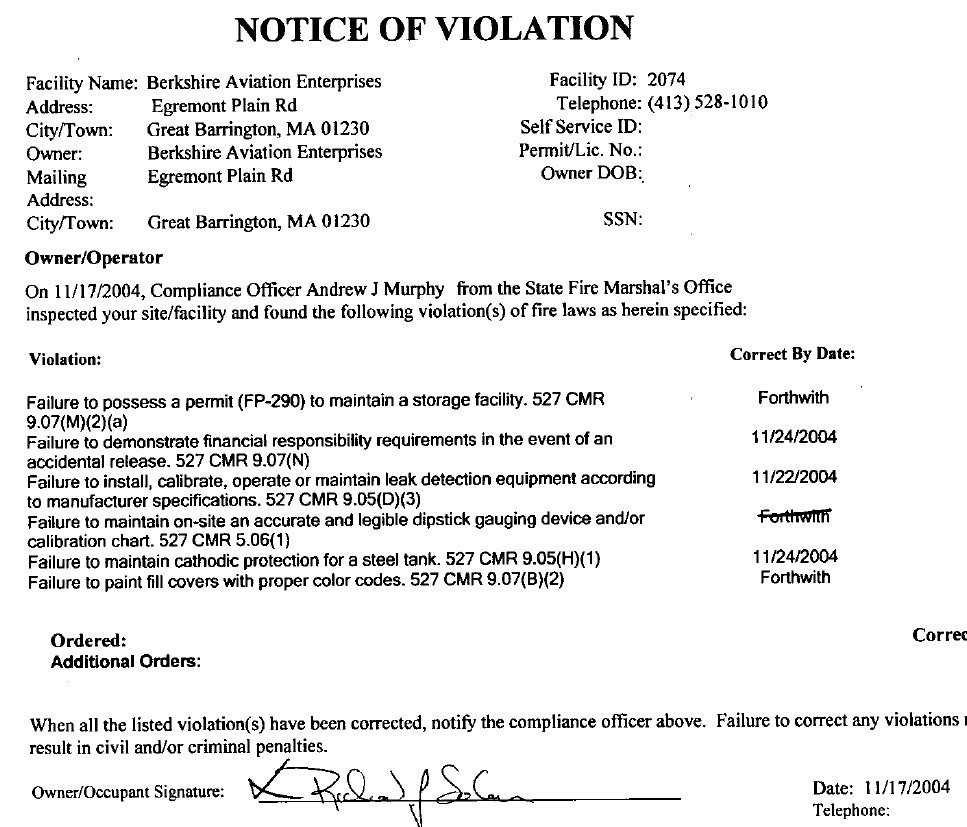
Some 2004 violations may have stemmed from transition issues after Koladza’s death. For a time, the airport was overseen by his elderly older brother, John Koladza, who was executor of his estate. But the airport’s operations were already being managed by the four pilots and mechanics to whom Koladza had left the airport and who would formally take over in 2008. Indeed, the 2004 DFS inspection report required that an owner acknowledge the findings and violations. It was signed by BAE majority owner Rick Solan.
A July 2010 report filed with MassDEP by Advanced Tank Testing of South Deerfield, Mass., noted more violations. While the inspector confirmed that the airport’s UST system could run required monthly tests, the tanks routinely did not contain enough fuel to return accurate results. And they were not being run regularly, in any event. “The passing tests (5) indicate low inventory levels are affecting the tests. The results call for tightness testing,” the inspector wrote, referring to a more intensive examination for very slow leaks conducted with special equipment by a trained inspector, recommended in the absence of successful monthly leak checks.
There were more violations that year. A permit to operate USTs was not available to show the inspector, and there was no evidence that required corrosion prevention was in place for some piping. The airport had also failed to conduct the required annual test of its line-leak detectors. A visit from a MassDEP inspector a month earlier as part of the agency’s “UST Facility Compliance Assistance Initiative” had once again found no on-site documentation of the required financial responsibility. (It provided evidence of private insurance the next month.)
Still, MassDEP took no enforcement action.
Three years later—the next time a full third-party inspection was required—a report highlighted many of the same failures, particularly on leak testing. “There are no passing test results due to low inventory. Fill tanks to proper capacity once per month to get valid passing tests,” the inspector wrote on July 23, 2013, echoing results and recommendations from 2010.
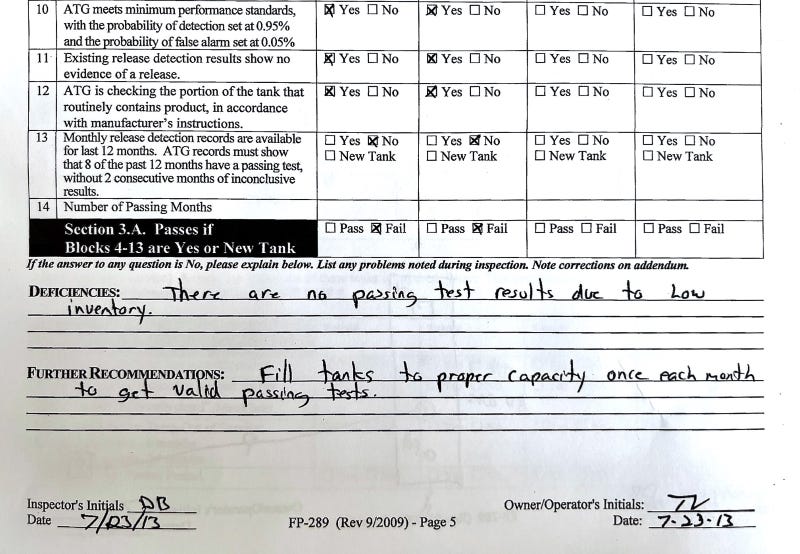
The inspection reports were all filed with MassDEP; identifying and following up on compliance failures is part of its oversight responsibility. Typically, agencies work collaboratively with facilities to help bring them into compliance. That benefits both the enterprise, which can be liable for significant cleanup costs, and the community in which it operates. But when substantial violations continue, more is required.
After many years of failing to comply with UST regulations, and a related complaint filed with MassDEP by airport abutters Claudia Shapiro and Danny Bell, who were by then in a bitter and expensive zoning battle with BAE, MassDEP dispatched an agency employee, Daniel Balboni, to conduct an unannounced inspection. On June 26, 2014, he performed what’s known inside the agency as a “multi-media inspection,” examining every area where the airport is required to comply with state environmental regulations.
In his full report and also an internal memo specifically about the UST issues, Balboni cited the airport for violating numerous air quality, hazardous waste, and UST regulations. In October, the agency’s chief of compliance and enforcement, Saadi Motamedi, sent a formal notice of noncompliance. Addressed to Thomas Vigneron, one of the airport’s four owners, it listed the violations: failure to maintain solvent-consumption records for its parts washer; failure to properly label a container storing waste oil; once again, failure to properly conduct monthly leak checks and keep records—the same violation highlighted in 2004, 2010, and 2013; failure to conduct monthly reconciliation of the daily inventories of each UST; and failure to conduct, or at least maintain records of, its required monthly inspections of all components of the underground storage tank system.
The airport was required to respond within 14 days. According to correspondence obtained by the Argus, it didn’t reply until early December. The airport manager at the time, Dante Hesse—a former local farmer who is now a commercial airline pilot—wrote to the agency: “Please excuse the late response to the letter we received on October 17, 2014,” the letter began. “However Thomas Vigneron is no longer working for Berkshire Aviation and we have been scrambling to get up to speed on many of the items he was responsible for.”
In that letter and subsequent email exchanges with Motamedi and Balboni, Hesse conceded that BAE did not run proper tests, inspect its UST system monthly, or comply with required recordkeeping. But he said he was working to address the violations. After Balboni re-inspected the airport in mid-April 2015, he was satisfied with BAE’s progress on most items, according to internal MassDEP emails. Ultimately, the airport remained out of compliance for more than 14 months, until December 31, 2015.
Murray, the DFS compliance official, also sits on the decision-making board of the state-cleanup fund, which can cover up to $1.5 million of the costs of environmental cleanup connected to an underground fuel release from a UST system. For those enrolled in that program and in compliance, it meets the “financial responsibility” requirement of state and federal law.
However, the program doesn’t cover tank systems holding aviation fuel. That means the airport’s aviation-fuel USTs had to be covered by other financial-responsibility guarantees that can include private insurance, bonding, or a letter of credit, according to the Department of Revenue’s Bullard, who runs the fund.
Still, in years of filings with state agencies by Koladza and others, including before triannual third-party inspections were required, BAE indicated that it met that responsibility by checking the box for “State Fund.” That may have been the case for its gasoline tanks—at various times it had USTs holding automotive gasoline and diesel—but that state program doesn’t cover aviation-fuel tanks. Over many years, when inspectors cited the airport for not showing compliance with that requirement, its unclear if the airport simply didn’t have paperwork on-site to show an inspector, as required, or if it didn’t have proper insurance coverage at the time of the inspection.
Murray told me this week that the first thing considered when deciding whether to pay for environmental cleanup—whether it’s the state fund or a claim made to a private insurance company—is whether a facility was in full compliance with relevant regulations when a fuel release took place. (The expensive Carpenter’s Variety fuel cleanup on Main Street ultimately fell to the state to cover.)
“You have that obligation to stay in compliance or you’re not going to be covered,” he said. “Because more than likely your lack of compliance contributed to the release.” He said the state fund covers anything that might have contributed to an underground release, like “a pipe that had a failure, or the double-walled containment didn’t work right and didn’t go into alarm when the tank started leaking.”
Ultimately, ongoing compliance is vital. “There’s a reason all these safeguards are in place,” Murray said, referring to both leak-detection features and the many requirements for testing and oversight. “And when you don’t fully comply, there’s a good chance you’re going to have something go wrong. It’s only a matter of time.”
In Great Barrington, the water-quality bylaw provisions make clear who’s responsible for environmental damage in the WQPOD: “The cost of containment, clean-up, or other action of compliance shall be borne by the owner and operator of the premises,” it reads.
Since the airport completed installation of its new tank in 2018, and Joe Solan took over as airport manager, BAE has improved its UST compliance record. But it was issued a notice of noncompliance in 2021 for failing to confirm that it was complying with state regulations. It submitted the required documentation three weeks later.
A MassDEP spokesperson told me last week that there have been no inspections by agency staff at the airport since 2017.
“Sins of the airport’s past”
In several conversations over the winter, Rick Solan described BAE’s poor record of regulatory compliance as “the sins of the airport’s past.” He said that during those years, he was working full-time as a pilot at American Airlines; day-to-day operations and regulatory compliance were left to others.
Solan recalled that both he and Vigneron made entries in a daily log of fuel levels. But in the years after Koladza’s death, he said Vigneron oversaw the USTs. “Tom was in charge, he was doing that,” he said. Indeed, it was Vigneron who initialed the third-party inspection findings in both 2010 and 2013. Solan told me that he’s not trying to shift blame to Vigneron, but only note that his limited time at the airport during those years was spent on flight instruction and other responsibilities. He retired from American in 2020 and has since been at the airport nearly every day. (Vigneron died in 2019.)
In many cases—as in Hesse’s communications with MassDEP—the airport blamed compliance problems on transitions between airport managers. When I asked Solan how the airport will ensure it stays on top of its compliance obligations after Joe Solan’s upcoming departure for what the younger Solan hopes will be an airline career, he said he’s going to do it himself—and that Joe Solan has been instructing him. “The son is now training the old man on how to do it correctly,” Solan said. He told me he plans to complete the coursework and certification the state requires for UST operators.
Municipal oversight lacking
Under the WQPOD provisions adopted in 2006, three municipal entities are specifically empowered to monitor the airport’s UST compliance. They are the Fire Department, Board of Health, and Building Department. A representative of those departments may, at any time, ask the airport to provide records of its UST leak testing and show that it’s in compliance with state regulations. They may also make unannounced inspections at the airport to review those records in person.
The bylaw also empowers the building inspector to issue violations of any WQPOD provision. The provisions that allowed the airport to continue to keep fuel underground—and upgrade its tank to a safer one—require that “any and all state and federal requirements and permits shall be met and obtained as required.”
In November, the Argus submitted public-records requests to all three town departments, seeking any indication they have used their authority to monitor the airport’s compliance with state regulations since the WQPOD took effect.
Records provided by the Board of Health included only a copy of the 2017 soil and private well-water tests done by the airport and copy of a septic-system inspection, but nothing related to UST oversight. During the Board of Health’s recent hearing on the airport’s special-permit application, board members raised numerous concerns about fuel storage above the aquifer and other environmental issues that it passed on to the Selectboard. It’s unclear if they were aware of their existing authority.
In late January, when I spoke to Great Barrington’s Health Agent, Rebecca Jurczyk, she said her office has not done any inspections or reviewed the airport’s UST records. “We have not done any inspections there and we don’t regularly do that,” she said. She told me that it’s not just the airport; they don’t have enough staff resources. “That’s not something we would do for any business,” she said.
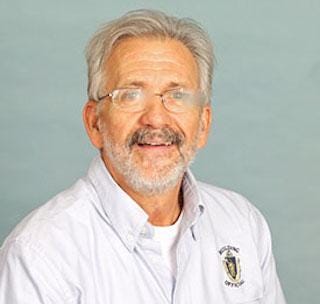
There were no records provided by the Building Department related to UST leak-testing compliance. Other records and internal town emails obtained by the Argus show that Building Inspector Ed May has, at various times, interacted with the airport on matters ranging from neighbor complaints about runway lights not turning off after 15 minutes, to email discussions among town officials about the airport’s use of on-site avgas trucks to fuel aircraft in 2017-18.
May also attended at least one meeting in July 2010 related to a previously unreported plan the airport advanced to build hangars without first seeking proper zoning approval—a proposal that May rejected. In a letter, he told BAE’s contractor that the building-permit application was deficient in several ways. But primarily, he said the project would first need a special permit “to construct and expand use” in the WQPOD and also because of the airport’s preexisting nonconforming status. According to the documents, BAE abandoned its plan after that meeting.
May, who joined Great Barrington’s Building Department in 2007, is no stranger to the airport. At the April 2022 ZBA hearing that became the basis for the zoning-enforcement case now in state Land Court, he told board members that he has a cardboard box filled with documents from the “innumerable times” the airport has shown up on his radar. “[That’s] one thousand times what a normal address would generate,” he said.
In response to the public-records request, the Great Barrington Fire Department provided the Argus with all documents in its file related to the airport’s USTs. Charles Burger, a 20-year veteran of the department who rose to chief in 2013 and is leaving his post at the end of March, told me in an email that he generally leaves UST regulatory compliance to state agencies.
Still, Burger said the department requires all UST facilities in Great Barrington to provide copies of their third-party inspection reports before local fuel-storage permits are renewed. And he wouldn’t hesitate to revoke a permit if he felt there was imminent danger. “If there is a reason to believe there is an immediate hazard their permit would be revoked,” he said. “If they are noncompliant due to recordkeeping, etc., then we leave the enforcement up to [MassDEP].”

But the documents provided by the Fire Department include only portions of the airport’s third-party inspection reports from 2013. They showed successful tests of some leak-testing and corrosion-prevention features but did not include the full report that highlighted the ongoing, years-long failure to properly complete the monthly leak-testing itself.
When I sent Burger the airport’s full 2013 third-party inspection report and MassDEP’s 2014 letter of noncompliance, he said the department wasn’t copied on the 2014 letter. That was unusual, he said, because typically MassDEP notifies the Fire Department. He also said he thought the department received the airport’s full 2013 inspection report and had sent it. But it was not included in several collections of documents provided by town and Fire Department staff.
If the department did receive the full July 23, 2013 inspection report, there’s no evidence any action was taken. According to records provided by the Fire Department, two weeks later, on August 5, 2013, the airport applied for and received a new three-year fuel storage permit. At the time, its steel single-walled USTs were both nearly 26 years old. (The earlier UST violations occurred before Burger became fire chief.)
The airport is not the only UST facility in Great Barrington that has fallen short on compliance, perhaps with little town oversight. According to records obtained by the Argus, Charles W. Agar, Inc., the Hurlburt Road fuel-oil company that had 11 underground tanks with enough capacity to store more than 100,000 gallons of petroleum products, also failed a host of compliance inspections by state agencies and third-party inspectors from at least 1999. That included a February 2007 order from the state fire marshal to stop using its tanks until it addressed 10 different open violations, many of which had been previously identified in an inspection three years prior. The company quickly resolved the issues after that order, according to DFS records. (Agar was acquired by Mirabito Energy in 2014; its underground tanks were closed-in-place in June 2018, a year after the state deadline.)
Located in the same residential neighborhood as the airport, the Agar property was spot zoned for business by a town vote in 1939, allowing a fuel-oil business to operate there. That approval came despite vocal opposition from the town’s Planning Board and neighbors on Hurlburt Avenue. It capped a contentious, multi-year battle that began with a proposal to install two 10,000 gallon underground tanks.
In 1999, MassDEP records document a 50-to-75-gallon fuel-oil spill at the site that led to several years of cleanup measures, state monitoring, and an audit of the cleanup—which identified numerous inadequacies of the remediation effort—amid concerns of contamination of nearby private wells. Reports filed by state inspectors during that period suggested there had likely been other unreported fuel releases over the years.
When the WQPOD groundwater-protection boundaries were drawn by town officials in 2006, the new district stopped just feet from the Agar property line.
(DISCLOSURE: Charles W. Agar, Inc. provided heating oil and oil-burner maintenance services at my home from 2008 to 2014.)
Is more oversight needed?
Had town officials looked more closely, they would have also discovered decades of inconsistent and inaccurate reporting by the airport to state authorities. Documents obtained by the Argus going back to the 1980s show that filings with state agencies by Koladza and recent BAE ownership sometimes misstated what type of underground tanks were in use at the airport, what kind of piping systems they had, what type of corrosion protection was in place, and in some cases even what kind of fuel was stored in each tank. (In the mid-1980s the airport’s many underground tanks held leaded avgas, jet fuel, heating oil, waste oil, and motor-vehicle gasoline.)
The airport’s representatives have always maintained in front of town boards that they’re in compliance with state regulations. But they were never questioned in depth or asked to provide documentation. Other than the Fire Department’s receipt of some inspection reports, there’s no evidence that any town board or municipal office sought, reviewed, or acted on UST compliance failures.

In December and January, prior to the airport’s filing of a new special-permit application, I spoke with four of five Great Barrington Selectboard members. Among other topics, I asked whether the town should use its existing authority under the WQPOD to perform more oversight of the airport and its underground fuel storage, given its location above the aquifer. The response was mixed. At the time, we didn’t specifically discuss the airport’s compliance record, and with a public hearing underway today, board members typically will not comment outside of that process.

Ed Abrahams, who will leave the board later this spring after serving since 2014, told me in late December that he’s confident the airport’s new double-walled tank is safe even though he was a vocal critic of the town’s handling of tank-replacement project. He told the Berkshire Eagle in 2018, “If we don’t go through the proper procedure, we’re being good-old-boys and approving this because we like airports. Nobody has said it’s a good idea to bury gasoline on top of a water supply.”
When we spoke, he pointed to the way municipal officials didn’t want to get involved. “What bothered me was there was no oversight,” Abrahams said. Even after the ZBA determined no special permit was required for the tank replacement, Abrahams spent months asking for clarity and action around the airport’s use of those fuel trucks that, initially presented to town officials as temporary, remained in daily use for 10 months.
When I asked Abrahams about increased oversight, he conceded he hadn’t considered the question of ongoing monitoring of the airport’s UST after the tank replacement matter was over. But he’s willing to consider it now. “I don’t know how much time or resources go into checking on a regular basis,” he said. “Maybe at least see if it’s worth checking into on an annual or semi-annual basis or something like that.”
Board Vice Chair Leigh Davis expressed some interest but had concerns about staff resources. When I spoke to her in early December, she said her daughter was seeking an appointment to the Air Force Academy. “She wants to be a pilot,” Davis told me during our interview. “That’s completely separate from the airport.” (On February 27, the day of the first public hearing on the airport’s application, she filed an “Appearance of Conflict of Interest” form with the Town Clerk noting that her daughter had been accepted and may soon take flight lessons at Great Barrington Airport.)

On oversight, I asked her if the WQPOD provisions were enough. “It would be nice to have some kind of local control, but I don’t know if we have the resources or expertise to really oversee that,” she said, suggesting additional burdens on town employees. “I think something needs to be done, but I am not in a position to offer any suggestions.”
Still, Davis said that fuel storage and environmental issues would be part of her review of any airport special-permit application. “Any kind of environmental concern is a big deal for me. And that would be part of what I’d weigh in my decision. Whether it’s the airport or anything in town, that’s something we need to focus on.” She said she’ll want to see “facts and research” on the various environmental questions.
Steve Bannon, who was on the Selectboard for both prior airport applications and has served as chair since 2018, told me in an early December interview that, in general, special-permit processes should be based on good information. “People need to get the facts, and they should get the facts.” He pointed to the time and expense invested by those who come before the board with proposals. He also said the board is willing to engage other experts when it needs more data or analysis.
Bannon told me that he had recently met with Rick Solan and another airport representative. “It’s always useful to talk to people,” he said. During the 2020 process, he said, he met with neighbors and went to their houses to learn more. He said he doesn’t express opinions in those discussions. “That’s for an open meeting and for the Selectboard to discuss. But I’m more than happy to listen to people’s opinions,” he said.
On the question of environmental issues and oversight of the airport’s UST in the groundwater-protection district, he does think the town should use its existing authorities. “It’s our responsibility to look at record-keeping and look at what’s in our jurisdiction by using people and committees that have the expertise,” he said.
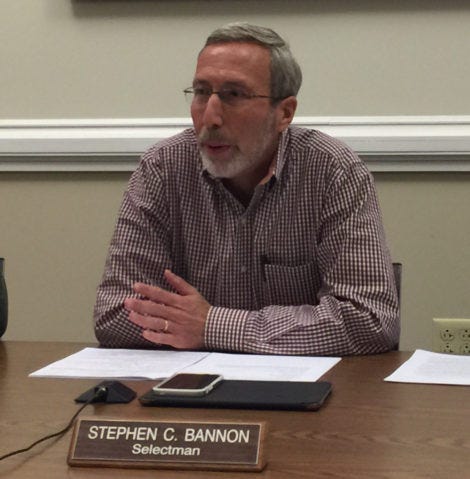
More generally, though, Bannon said he defers to state regulators. “I actually think the state is the expert on this. And they should be overseeing it. I try not to become an expert on a topic that I’m not trained in and don’t know enough about,” he told me. “If someone can prove to me that the airport or any other applicant is not following state or federal regulations, then I would be the first one to say, ‘Why not?’” Bannon said that kind of information “would affect any application,” and he’d want to contact the relevant regulatory agencies to find out more.
As he told me early in our conversation, he wants town discussions to be about facts. “I think if somebody wants to bring up something of that nature at a special permit [hearing], they better have proof that the applicant’s not following the regulations,” he said.
In a January conversation about various airport and community issues, Selectboard member Eric Gabriel said he’d look into the question of oversight of the airport’s environmental compliance. Garfield Reed, another board member, did not respond to two emails sent in December seeking an interview.
Abandoned plans for an above-ground fuel tank
The recent debate over fuel storage in that environmentally sensitive location has been consistent and perhaps predictable: BAE’s owners, local pilots, and airport advocates insist the risk is low thanks to the new tank, while airport critics suggest it’s too big a risk because of the water supply.
During the 2017 hearings, the airport addressed concerns about fuel storage by announcing it would replace its two underground tanks with new above-ground fuel storage. Indeed, in late 2016, BAE applied to MassDOT for a $100,000 state grant to pay to remove its underground tanks, according to documents obtained by the Argus. The application described plans to install a new, much smaller 4,000-gallon above-ground tank by May 2017. (The grant was not awarded, according to MassDOT spokesperson Kristen Pennucci.)
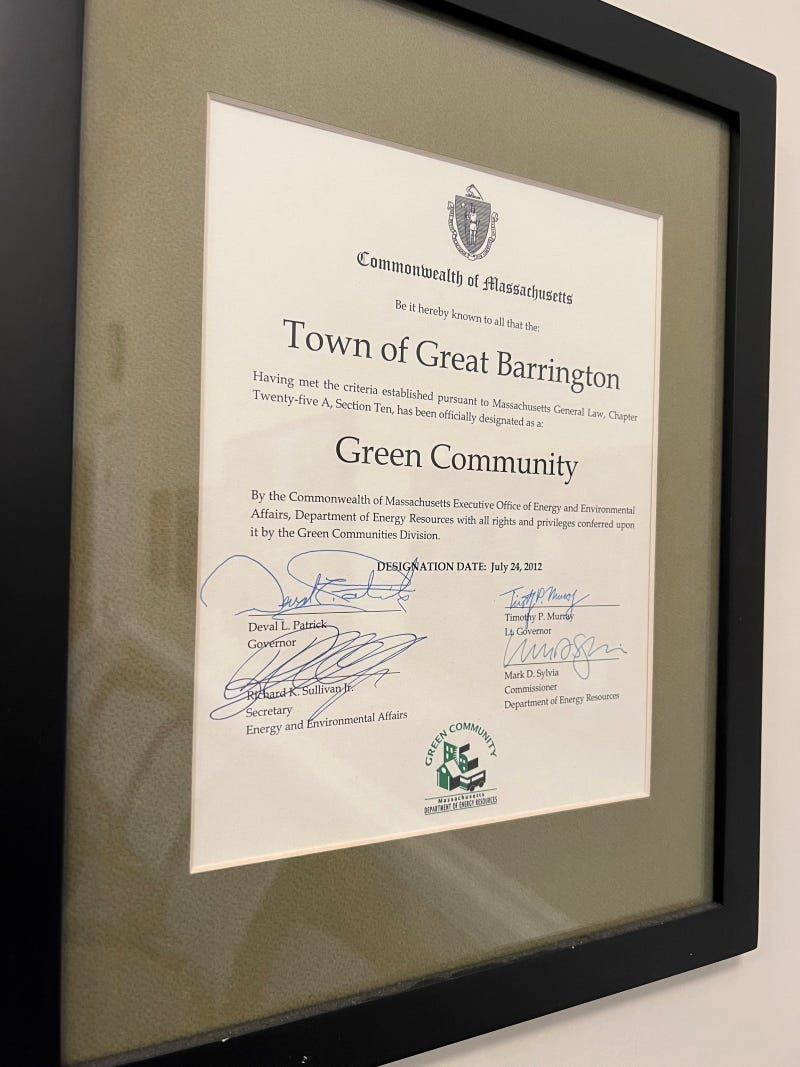
Rick Solan, airport attorney Lori Robbins, and then-airport manager Ken Krentsa all told the Selectboard that a new above-ground tank would solve the problem. “There will be no aviation fuel underground at the airport,” Solan told the board on March 27, 2017. “[That] will alleviate a lot of the problems for the safety of the water. We chose to do this at a higher cost to preserve the land and not have any chance of fuel going into the river,” he said. The equal-or-more-significant danger is that a petroleum release would flow downward into the aquifer; a rule of thumb is that one gallon of gasoline will contaminate a million gallons of water.
Such a move would align with recommendations from every Massachusetts and federal transportation and environmental agency. Pennucci told me last summer that MassDOT recommends that all fuel storage at airports be above ground. “The Aeronautics Division could fund above ground fuel tanks through [MassDOT’s] Airport Safety & Maintenance Program when funding permits,” she said in an email. “USTs are not recommended for installation as they contain [fuel] that can quickly move through soils and contaminate groundwater, so Aeronautics would not pay to install them.”
That policy mirrors advisories from the Federal Aviation Administration (FAA), which prioritizes above ground fuel storage at its own facilities and requires special approval for underground tanks. In both cases, they are in alignment with EPA guidance that has, for decades, pushed to minimize risks to the environment.
Despite those recommendations and the lack of available grant funding, Solan told me in December that after the airport withdrew its 2017 special-permit application, he changed his mind. He said it was because of aesthetics—preserving the historic look and feel of an old-timey airfield—and what he said were safety concerns over aircraft collisions with fuel tanks. He also told me that he worried about the security of above-ground tanks: Two of the airport’s flight-school planes were reportedly vandalized in a May 2017 incident that remains unsolved.
Mark Roggen, a pilot and business consultant who helped the airport with its UST-replacement project, mirrored that view in a Berkshire Eagle interview. “We had some incidents that made us think an above-ground tank would be more vulnerable,” he told the Eagle. He also suggested, as Solan did, aesthetic reasons: “Who wants to be looking at a tank?”
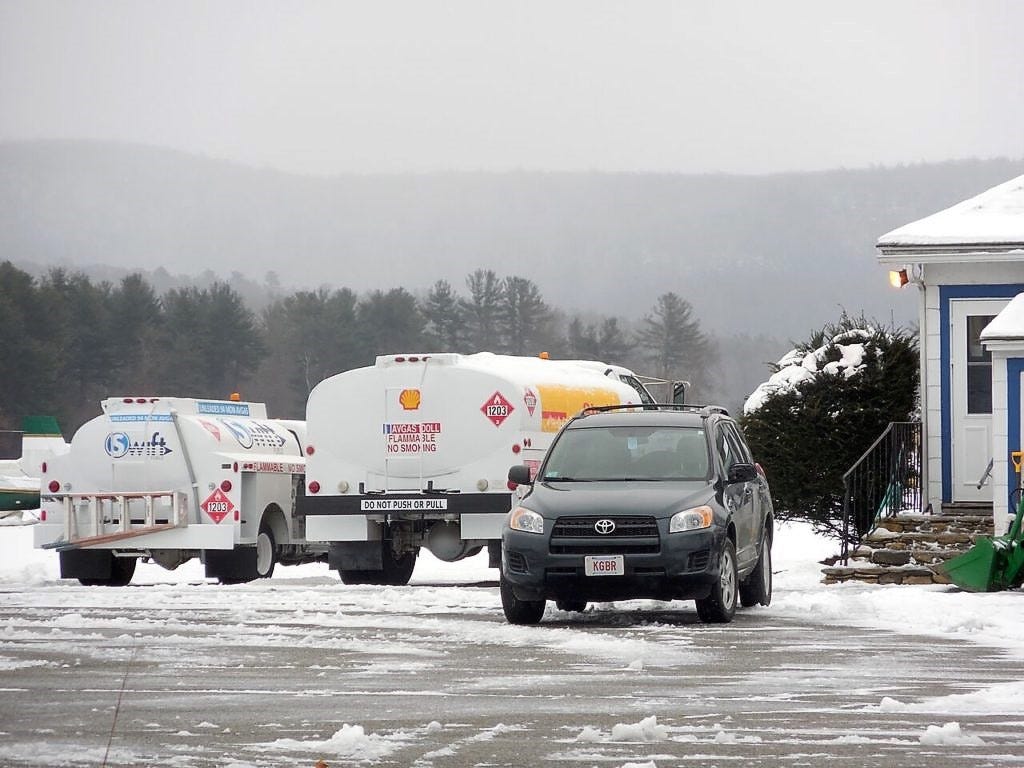
There’s no evidence that town officials encouraged the airport to stick with its plans for an above-ground tank after the special-permit application was withdrawn. E-mails obtained in a public-records request by the Argus, including a summary of the project sent by Krentsa to town officials two months after the state’s tank-removal deadline, show that the airport originally planned to spend $155,000 on the project. It was to begin on November 20 and be completed approximately two weeks later. It took almost 10 months, with only part of the delay due to a zoning-enforcement request. There was nothing in e-mail threads reviewed by the Argus that discussed the airport’s original plan for above-ground storage.
Is the airport surpassing WQPOD limits on hazardous waste?
When the Selectboard turned down the airport’s special-permit application in 2020, its findings noted concern about increased hazardous-waste production at a busier airport. “The potential for increased use of the airport’s maintenance facility is likely to increase the amount of hazardous waste material in the WQPOD,” they wrote.
Among the restrictions imposed by the water-protection bylaw is a limit on the production and storage of that hazardous waste. But how much waste oil, which EPA and MassDEP both categorize as hazardous waste, does the airport produce today? And is that waste oil much different, or any more concerning, than what’s generated by Great Barrington’s many automobile-repair shops?
Airport advocates have long suggested the risks from gas stations and their underground tanks and auto-mechanic shops and their hazardous waste are no different or more environmentally dangerous than what happens at the airport. But a key distinction, airport critics often note, is that the airport is both in the WQPOD and sits directly on top of the aquifer.
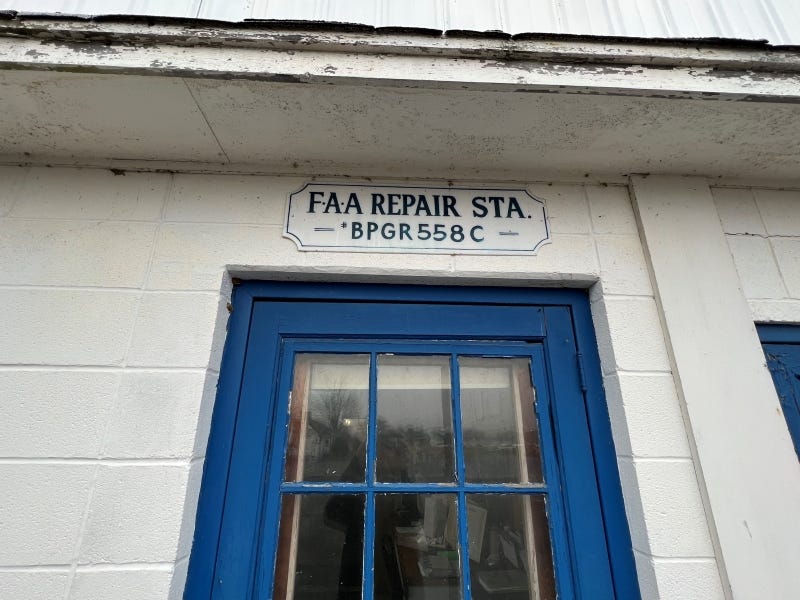
While explicitly prohibiting most activities that produce such waste, the WQPOD provisions make a few exceptions. Relevant to the airport’s operations, it allows state-registered “very-small-quantity generators” (VSQG) of hazardous waste to operate in the water-protection district.
As required by MassDEP, the airport is registered with the Environmental Protection Agency under the federal Resource Conservation and Recovery Act (RCRA), a 1976 law that provides a framework and baseline for state hazardous-waste regulations. According to information filed with the EPA and MassDEP in 2015, the airport says it is a very-small-quantity generator of five types of hazardous waste: ignitable waste, benzene, tetrachloroethylene (used as a parts-cleaning solvent), waste oil, and what’s called “off-specification” waste oil, which contains contaminants at levels above EPA limits.
According to MassDEP regulations, a VSQG may not produce more than 220 pounds of hazardous waste, or 27 gallons of waste oil, per month. And no more than 270 gallons of waste oil or 2,200 pounds of other hazardous waste may be accumulated on site.
The WQPOD language also includes an exemption for “waste oil retention facilities,” defined in both state law and the Great Barrington zoning bylaw as “automobile service stations, marinas, and retail sales outlets,” but not airports. (Malcolm Fick, a Planning Board member, told me last week that, in his opinion, this provision covers the airport.)
In 2017, the extent of the airport’s submittals to the Selectboard on hazardous materials and waste was one short email. Burger, the fire chief, reviewed it and signed off. He wrote in an email shared with the board that the airport had all necessary permits and managed its hazardous materials and waste “in accordance with recommended practices.”
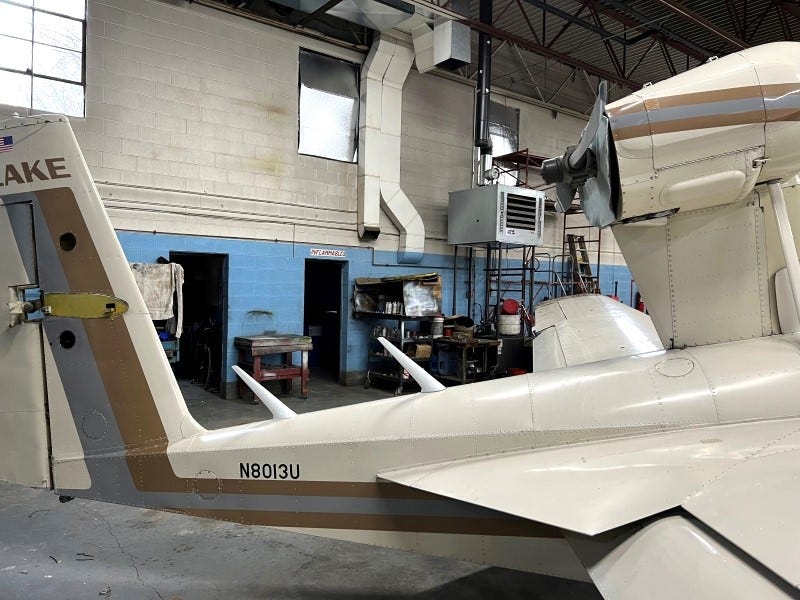
Rick Solan told me earlier this year that BAE’s flight-school planes typically get oil changes at 35 hours of flight time, which he said works out to every month or month-and-a-half. (BAE currently has eight flight-school trainers used for differing numbers of hours each month. In the Argus’ analysis of flight-tracking data for one of those planes from last September, it operated for more than 75 hours.)
He also told me last month that BAE’s maintenance operation, which now has three full-time mechanics, is quite busy. “Maintenance is what’s always carried the airport in wintertime,” he said. “But this is the busiest one I’ve seen in a long time.”
Aircraft-engine manufacturers like Lycoming recommend oil changes after 25 to 50 hours of flight time, or, at minimum, every four months regardless of hours. Piston aircraft engines typically take eight quarts of oil, or two gallons, with some absorbed into the oil filter and, depending on engine performance, lost during operation.
That would appear to limit the airport to no more than roughly 13 to 18 oil changes per month. Beyond 27 gallons of waste oil, it would exceed the limit of a VSQG and be required to register as a small-quantity generator—a level of hazardous-waste production not permitted in the WQPOD. (There is no special-permit option that allows exceeding VSQG limits.)
Jeff Dodge, the longtime head mechanic at BAE who one pilot told me is “the Piper Cherokee whisperer” for his uncanny ability to identify otherwise hard-to-find engine and aircraft quirks, told me in January that his operation currently does “six to eight” oil changes per month.
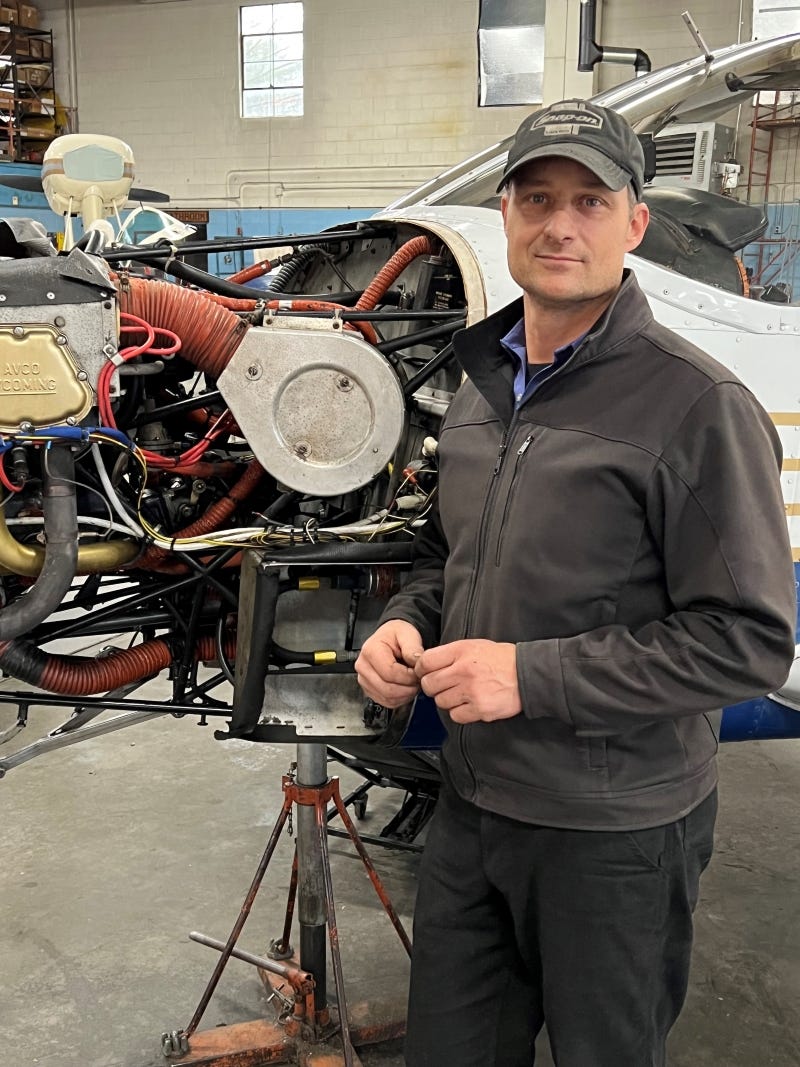
According to MassDEP regulations, the airport is required to maintain detailed records of how much waste oil it generates and how it’s managed. The airport has never provided this information or any documentation of its status as a VSQG to town officials; its representatives and attorneys have only pointed to its registration with EPA and MassDEP.
The last full inspection by MassDEP to assess the airport’s compliance with hazardous-waste regulations, including examining its records of hazardous-waste production, was in June 2014. The inspector said the airport “appeared to be in compliance” with the hazardous-waste production and storage limits of a VSQG.
When I asked both Rick and Joe Solan if they would share the airport’s recordkeeping on waste-oil production and disposition, they declined. But they said that information would be made available to municipal officials if requested.
According to MassDEP spokesperson Kathleen Fournier, hazardous-waste producers are required under state law to update their status to match their operations. “As with all registrations for hazardous waste and waste oil generators,” she told me in an email last week, “the onus is on the generator to register their status [and] to update their status as appropriate by submitting adequate information in support of that status and is responsible for operating in compliance with the applicable regulatory requirements.”
Earlier this week I contacted Building Inspector Ed May and asked if he’s ever undertaken enforcement action to ensure compliance with the water-quality district’s various prohibitions. I also asked if the town ever audits entities in the WQPOD to see if they are exceeding hazardous-waste limits. In an email, May said “yes” to the former and “no” to the latter.
According to other documents obtained by the Argus, in December 1990, former airport owner Walter Koladza filed paperwork with MassDEP at the next level of hazardous-waste producer. He said the airport was a small-quantity generator of waste oil, stating in a submittal to the agency that the airport produced 60 gallons of waste oil per month. That’s more than double what’s permitted today under the water-quality bylaw.
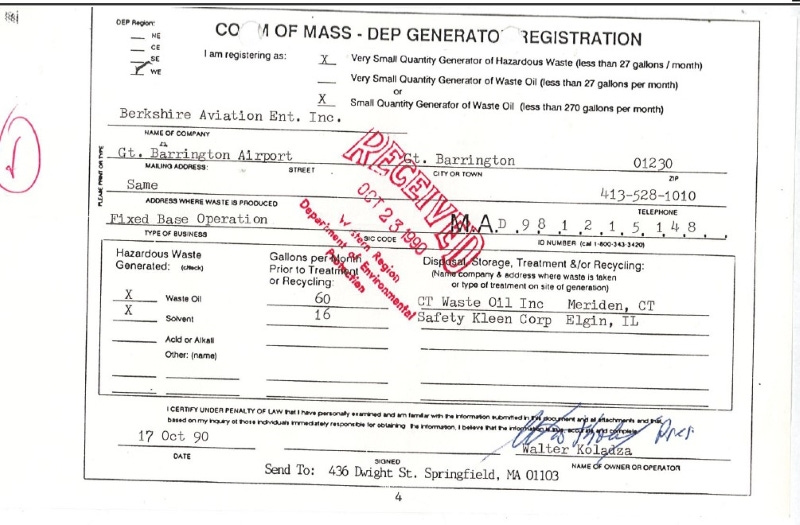
Solan told me last week that Koladza’s claim of 60 gallons per month might have been accurate decades ago, but perhaps only until the mid-80s. Back then, he said, Koladza had more planes, including several large twin-engine aircraft used in BAE’s busy charter service. The maintenance of those aircraft would mean more waste-oil production. But he said those planes were all sold in the early and mid-1980s, several years before Koladza’s 1990 filing with MassDEP.
That filing could establish a preexisting nonconforming level of use, depending on what’s happened since. As a zoning-conforming aviation field, which the airport hopes to become with its pending application, it’s unclear when it would have to comply with all provisions of the WQPOD, including the VSQG limit. In an October 2020 memo to the Selectboard, Town Counsel David Doneski argued that at least if it builds new hangars, and perhaps in other circumstances, BAE will need a WQPOD-specific special permit and going forward comply with all WQPOD provisions.
Burning waste oil contaminated with lead
BAE disposes of that aircraft-engine waste oil in a space heater used to warm its maintenance hangar, according to testimony at public hearings since 2017 and confirmed in my conversations with Solan. And that’s generally legal under state law. “We save [the waste oil] for ourselves and burn it as we go,” Solan told me in December, noting that BAE recently purchased a new, more efficient waste-oil burner. “At nighttime [in the winter] the waste-oil heater kicks on, so it doesn’t get below freezing in there,” he said. Solan argued that keeping waste oil on site is safer than transporting it. “This way you don’t have to worry about an accident,” he said.
In 2015, the airport updated its hazardous-waste registration with MassDEP to comply with permitting requirements for burning “off specification” waste oil, according to documents obtained by the Argus. The difference between specification and off-specification is the level of contaminants: Both EPA and MassDEP set limits for arsenic, chromium, lead, and other elements in waste oil. Exceeding those levels can add additional requirements to its handling and disposition and whether it becomes a different category of hazardous waste. For lead, the EPA threshold is 100 parts-per-million (ppm).
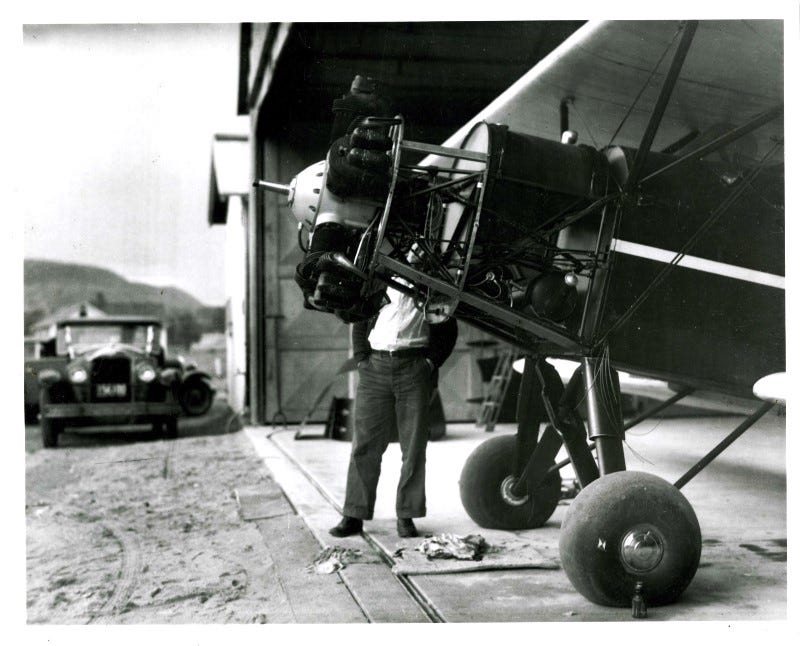
Because piston aircraft burn leaded fuel, their engine oil contains very high levels of lead—something that may have been overlooked by state regulators. Depending on how long the engine has operated without an oil change and on engine performance, lead in aircraft engine waste oil is commonly in the thousands of ppm. That’s far higher than the EPA limit and the 560 ppm of lead in aviation fuel.
When I spoke last week to Joe Adams, an analyst at Blackstone Laboratories, a Fort Wayne, Ind.-based provider of detailed engine-oil analysis for aircraft, he told me that engine-oil analysis can make an enormous difference in an ongoing maintenance program. By examining the level of various metals in the oil and understanding which engine components they might have come from, problems can be diagnosed and spotted early. “[Oil analysis] is understood as a necessary aspect of a pre-buy, ongoing maintenance, and whenever there’s suspicion of a problem,” he said.
According to sample reports from Blackstone, the concentration of lead is often more than 5,000 ppm, or 10 times the amount in leaded aviation fuel. And a study prepared for the FAA in 2008 found lead levels as high as 10,286 ppm for a Lycoming 160-horsepower aircraft engine after 100 hours of operation.
State law lacks clarity about when a facility burning its own waste oil in a space heater must test it for contaminants. MassDEP’s Fournier confirmed in a January email that off-specification waste oil can be burned in the Commonwealth. “However,” she wrote, “it is the responsibility of the operator to ensure the material is not contaminated to the point of being classified [as] hazardous waste. Hazardous waste is not permitted to be burned as used-oil fuel.”
That may be why nearby states have clearer and much tighter rules. Vermont’s air-quality regulations don’t allow burning off-specification waste oil in a space heater if it exceeds the EPA’s limit of 100 ppm of lead. Unless it’s done, for example, in an industrial boiler that meets strict, highly regulated air-quality rules established by the EPA.
Anna Bourakovsky, who is the hazardous materials program manager for the Vermont Department of Environmental Conservation, told me in January that even though burning lead-contaminated oil is permitted if done per those EPA requirements, she’s not aware of a single facility in Vermont that currently burns waste oil containing more than 100 ppm of lead. “If it crosses a threshold for any of the metals, PCBs, or total halogens,” she said, describing EPA standards for various contaminants, “it can’t be burned for energy recovery as it is.”
When I asked Rick Solan about the airport’s burning of lead-contaminated waste oil, he told me he wasn’t aware of any requirement to test for the level of contaminants. BAE’s Dodge told me that his shop sends samples out for waste-oil analysis, but the reports he receives only come back with “low, medium, or high” for various metals when compared to engine baselines. They don’t include specific parts-per-million information, he said.
In response to a series of questions during that February 9 Board of Health meeting, including queries about the airport’s handling of hazardous waste, airport attorney Dennis Egan said incorrectly that the airport’s waste oil from maintenance operations “is stored in 55-gallon drums and the airport [has] a contractor who takes that away and recycles it.”
Egan later told me in an email that he misspoke. He said the airport meets all MassDEP regulations related to the VSQG total-accumulation limit but didn’t address a question regarding the monthly-generation limit. In any event, he said, the airport’s operation is no different than “service stations, Jiffy Lube, or similar businesses [that] all handle similar oil in potentially greater quantities.”
Minimal town attention to hazardous materials and waste
To date, and despite some statements to the contrary, town officials have shown little interest in digging into the details of hazardous materials, like UST compliance, and hazardous-waste production and handling at the airport. Given the history of the airport’s relationship with town government since the 1930s that was explored in part two of this series, that may not be surprising or new.
For example, according to its own guidelines, a special-permit application to the Great Barrington Selectboard must be considered complete before a public hearing is scheduled. In the case of the airport’s current application, that includes providing a detailed list of hazardous materials or waste used, stored, and produced at the property and how it’s managed. It’s described in the special-permit application instructions under “Environmental Reports.”
The airport’s application did not address that requirement and included no information on those subjects. In early February, I twice emailed Selectboard chair Steve Bannon, Town Manager Mark Pruhenski, and Assistant Town Manager Chris Rembold asking if the airport had supplemented its application with that information. I also asked for details of the town’s procedure for evaluating applications for completeness before scheduling a public hearing. But they did not reply.
Egan, the airport attorney, told me in an email on March 8 that a list of the airport’s hazardous materials “is not a matter of public record,” but said he would forward it once airport staff has a list assembled. (It had listed some in a 2017 submission to the Selectboard.)
When the Planning Board considered the airport’s special-permit application on January 26, giving it a unanimous recommendation for approval, several board members asked Solan and Egan questions about leaded fuel, its underground storage, and hazardous materials. That board has a history of interest in these matters: In 2020, it passed on a positive recommendation for BAE’s hangars-and-aviation-field special permit but asked the Selectboard to “require documentation about the airport’s use and handling of hazardous materials.”
This time it made no such request. In response to a reporter’s question, Fick and Assistant Town Manager Chris Rembold suggested this application is different because there is no proposal to build hangars and therefore no “expansion” of the airport or its operations. The board’s longtime chairperson, Brandee Nelson, said her questions about the type of UST and board member’s other questions were an indication of their interest in environmental issues. “In terms of environmental protection, we are concerned,” she said. “A number of questions to the applicant were about how they’re operating and whether or not they’re maintaining compliance with the state and federal guidelines they need to comply with,” Nelson added.
When I followed up with her a few days later, to ask again about hazardous materials and underground fuel storage at the airport, she said that the description of the double-walled tank addressed her concerns. “[With] my background in environmental engineering and the specific requirements of fuel systems, I was satisfied to know they are currently using modern technology for safe fuel storage instead of old single-walled buried tanks,” she wrote in an email.
It’s noteworthy that in 2020, when the Planning Board asked the Selectboard to require documentation of the airport’s hazardous-materials management, the double-walled UST had already been in place for more than two years.
Water, air, soil, and lead
From its source in Canaan, N.Y., through Alford, Egremont, and Great Barrington to its mouth at the Housatonic River, the Green River is about 18 miles long. MassDEP classifies it as a Class B, Cold-Water Fish Resource; that means it provides vital habitat for both wildlife and aquatic life, as well as offering fine swimming and recreation for somewhat-less-aquatic life like us.
The United States Geological Survey has, since 1951, maintained a monitoring station at the point where the river intersects Hurlburt Road. It gathers data on the river’s height, rate of flow, and samples it for water quality. And the EPA’s waterbody report gives it a “good” rating; the only alternate designation would be “impaired,” the label it gives to the PCB-contaminated Housatonic River that flows through Great Barrington from its northern border with Stockbridge to where it meets Sheffield.
That “good” rating doesn’t make it drinking-water quality—though there was a time when Great Barrington residents filled their glasses with it. After building a dam on the river in 1887, the Berkshire Heights Water Company was authorized by state law to take “no more than 10 percent” of the river’s volume. (It’s worth noting that sewage was also dumped or piped into the river in those days; we might call that the Out of Sight, Out of Mind Era.)
Meanwhile, the Great Barrington Fire District, formed six years before Abraham Lincoln was elected president, eventually incorporated most other local water companies. It relied on the open reservoir on East Mountain as its water source. And it wasn’t always ideal. In Bernard Drew’s exhaustive 1999 history of Great Barrington, he quoted a stomach-turning editorial from a February 1900 edition of the Berkshire Courier weekly newspaper: “Not a hundred steps from East Mountain reservoir,” the editors wrote, “there has lately been dumped what is estimated to be no less than eight barrels of dead fish, spoiled meat, beef trimmings and all manner of butcher’s refuse. The smell is vile and as soon as thawing weather comes, if the stuff be not removed, the villains will be washed into the reservoir.”
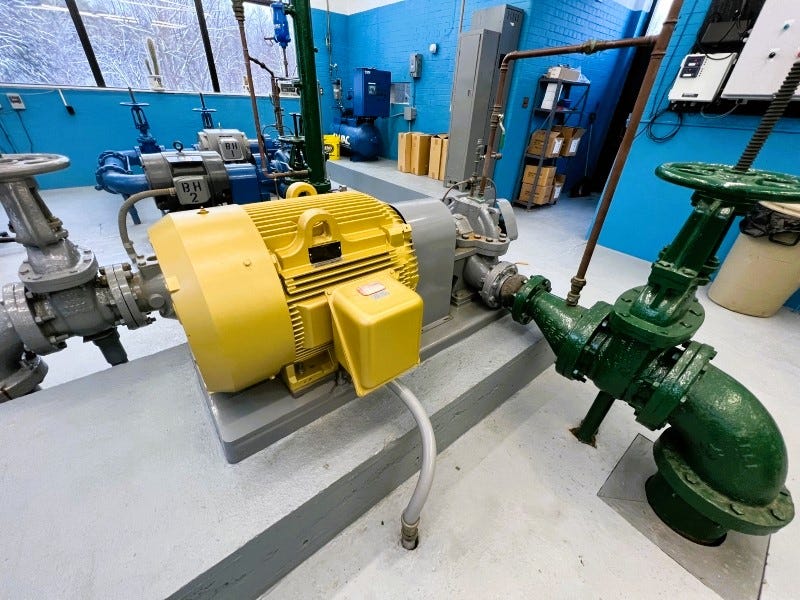
For some reason, that was on my mind back in January when Marks, the fire district superintendent, unlocked a metal door and led me inside the unremarkable Green River Pumping Station, which was built in 1934—not long after the establishment of the airport, which is less than a mile away. It’s a roughly 30-by-40-foot building that has the familiar, slightly unpleasant smell of a high-school locker room adjacent to a chlorinated pool. That’s because water pulled through the pumping station from the aquifer is treated with a small amount of sodium hypochlorite—supplied by Carr Hardware on Main Street, Marks told me—at a rate of about 0.4 milligrams per liter. It’s otherwise untreated and unfiltered by anything other than those layers of gravel, sand, and clay that have surrounded the infiltration gallery since it was constructed nearly a century ago.
That will change at some point soon. Marks plans to install a $1.6 million ultraviolet-light system that provides the most effective disinfection available, known as “4-log virus removal.” It will mean a reduction in the fire district’s use of chlorine, too.
And that’s a good thing, according to Sydney Evans, a drinking-water analyst at the Washington, D.C.-based Environmental Working Group (EWG). While noting the life-saving impacts of water treatment, she warned that disinfection byproducts—like those that have bedeviled Housatonic Water Works—are potentially unhealthy even at low levels. “As they’re disinfecting the water they’re mixing with other things, whether it’s organic matter or other contaminants,” she told me in January. “They’re forming these offshoot side products that are risky for our health.”
Testing the water(s)
Per state regulations, the fire district’s water is tested for various contaminants on different schedules: constant monitoring for those chlorine residuals and disinfection byproducts, monthly bacteria samples at nine locations, and other tests prescribed each quarter by MassDEP. Once every three years, water is tested for lead and copper at 20 locations across Great Barrington. Those lead-and-copper tests have shown results so low, for so long, that the fire district is today on the state’s most relaxed testing schedule. If there were higher levels or reason for concern, the lead-and-copper tests would happen more frequently. The last two were in 2018 and 2021.
That’s of interest in the context of the airport discussion because of its underground storage and burning of leaded aviation fuel—and what risks, if any, they pose to the water supply. Since 2017, that argument has been driven by claims of airport critics Marc Fasteau and Anne Fredericks that actionable lead levels identified in a 2017 test of their private well on Seekonk Cross Road could only have come from the airport. (As reported in part one of this series, they’ve long conceded they can’t prove a direct link.)
Former abutter and airport critic Joe Krummel told me in a January phone call that he also had well-water with elevated lead levels, though he couldn’t recall if it was at the level EPA considers actionable, which is 15 parts per billion. (I later asked for copies of any tests, but he didn’t respond to an email request.) Krummel relocated to the Hudson Valley in 2020. Despite claims made by airport opponents, he told me his move wasn’t related to his battle with the airport.
They’re not the only ones. In June 2017, high lead levels were found at the wellhead of another home on Seekonk Cross Road that directly abuts the airport, according to results shared with the Selectboard. In that case, it was at nine times the EPA’s action level. Still, there’s little evidence that nearby testing has been exhaustive or repeated. And some airport neighbors told me they don’t want to talk about elevated lead levels because of the potential impact on property values. By now, though, anyone considering a purchase near the airport is likely to test well-water for lead.
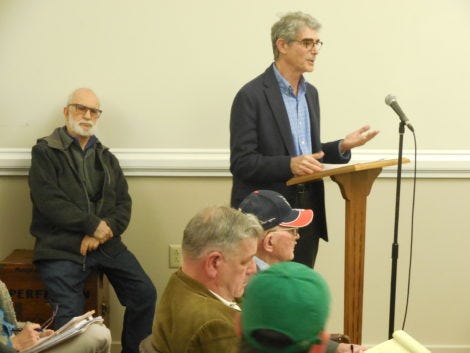
Fasteau and Fredericks have continued to focus on potential lead contamination in air, soil, and water. “Children may now be drinking lead-contaminated water,” Fasteau told the Selectboard in 2017. Their website, GBAirportFacts.com, says “the potential impacts and implications of concentrated lead exhaust on our water, homes, and food supply are significant.”
To airport supporters and advocates, without more substantial evidence, the claim about children’s exposure is nothing short of hyperbolic. Krentsa, the airport manager in 2017, told The Edge at the time, “[Fasteau] has given no evidence that supports his theory for his lead levels. He lives about three quarters of a mile away from the airport. Why imply that the airport has anything to do with it?”
While the Centers for Disease Control lists soil near airports as a significant lead-related health risk, the greatest overall danger is still from lead paint in old houses. According to EPA data, Great Barrington’s older housing stock puts it right at the median, 50th percentile of lead-paint risk in the United States, with a concentrated area downtown reaching beyond the 90th percentile.
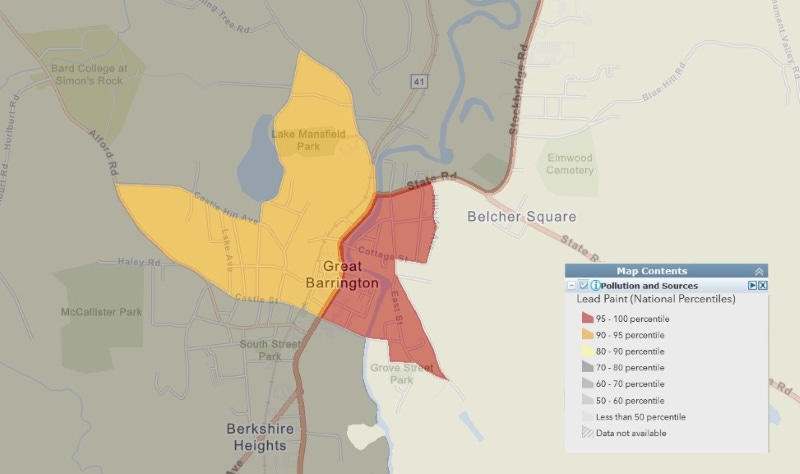
Still, given that no amount of lead is safe, especially for young children, environmental groups like EWG argue that drinking-water standards for lead and a host of other contaminants should be far stricter than EPA standards. (Read EWG’s analysis of water from both the fire district and Housatonic Water Works.)
That this airport-related debate is, like others, filled with hard-to-pin-down assertions is not surprising. Several airport advocates have for years dismissed suggestions about the airport’s contribution to nearby environmental lead with sometimes outlandish claims—including in front of the Selectboard—that Civil War cannonballs were made from lead found in this area. And that lead for pencils was mined here. (Lead has never been used in pencils; it’s a common misconception.)
Getting the lead out
Why does avgas use lead? In the early days of powered flight, the science of pairing petroleum to aircraft engines was naturally in its infancy. At the time of the Wright brothers, fuel had octane levels in the 30s. That octane level—the 87, 89, and 93 commonly seen at gas pumps—is a measure of how much compression fuel can tolerate before it ignites. Higher compression engines can produce more power—and especially before the arrival of electronic-fuel injection and other advances, more octane was the ticket to more power.
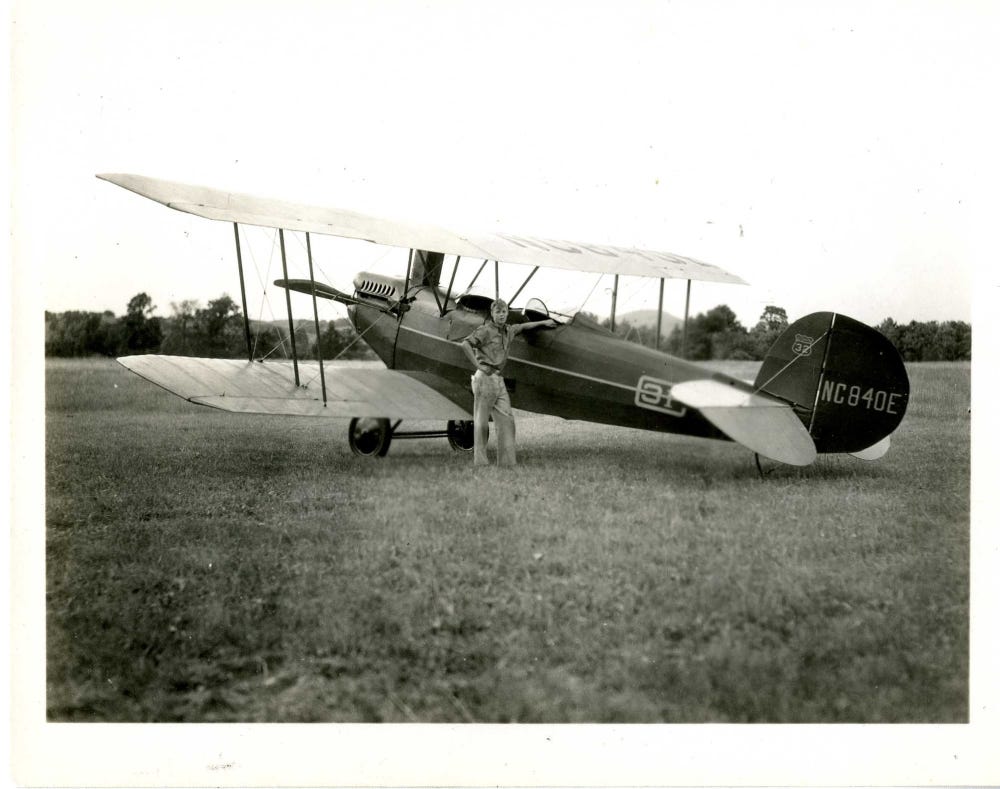
In the early decades of last century, oil companies, the military, and General Motors invested heavily to develop gasoline that could fuel the more-powerful engines they put into their automobiles and aircraft. Their success meant faster fighter aircraft that overcame German and Japanese planes in World War II. The F4U Corsair that Koladza sky-tested in Connecticut—essential to Allied victories—was powered by an engine that produced a remarkable-for-the-time 2000 horsepower.
The key to solving the problem of fuel pre-ignition in high-compression engines—“knock” and “ping” to you and me—was to add a liquid metal additive. (In aircraft, pre-ignition can lead to catastrophic engine failure.) Several were tried, but lead ultimately won out, allowing octane ratings to reach 100 and higher.
The general-aviation industry knows there’s a spotlight on the health dangers from leaded aviation fuel, particularly where there are battles over local airports. And in the wake of recent studies that show higher blood-lead levels in children based on proximity to general-aviation airports, the industry is simultaneously taking notice and, at times, continuing to urge a slower pace.

Sean Collins, the eastern regional manager at the Aircraft Owners and Pilots Association (AOPA), told me in January that his organization takes the issue seriously. “We view lead as the single greatest threat to general aviation right now,” he said. He suggested that slow progress over recent decades in developing lead-free avgas alternatives is because of the size of the market. “What we burn in an entire year is what the automobile industry has burned by lunch in a single day,” he said. “That’s not meant as an excuse,” he added. “It just didn’t rise to a level of priority like automobile-lead use did in the 1970s and 80s.” (Avgas is indeed a small market, but the per-gallon profit margin is far higher than for automobile fuel.)
Others argue the problem is deeper and more complex: They say decades-long delays stem from the lobbying power of the oil and aviation industries, bureaucratic inertia, and disparate pockets of organizing rather than a national movement for change—which may be changing. Collins conceded it’s seen as a criticism of the aviation industry that it’s taken this long. “It’s just a human tendency to take the easy road until we’re forced to do something else,” he said. But he believes the EPA’s recent endangerment finding on piston-aircraft lead emissions—the result of two decades of legal action by environmental-justice organizations—will help. And he pointed to AOPA’s continued involvement with the FAA’s collaborative EAGLE Initiative that seeks an unleaded alternative by 2030. “At the same time,” he said, mirroring what AOPA has said in recent Congressional testimony, “we’re expecting that government is going to recognize the fact that it’s not as simple as flipping a switch.”
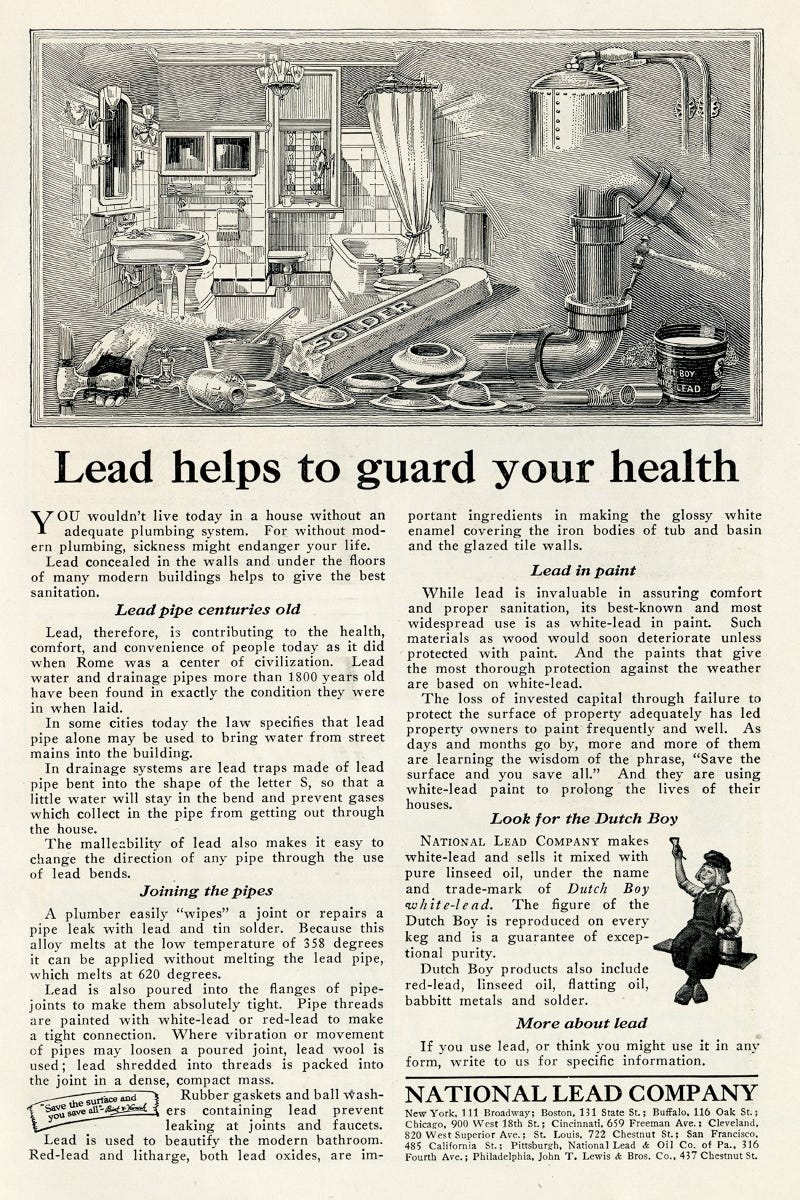
Jonathan Smith, a lawyer for Earthjustice who works on this issue, told me in an interview last summer that a finalized endangerment finding will be an important development. “The next step is that EPA works with FAA on actual regulation,” he said, recognizing that will take multiple years. How and whether Congress might get more involved is an open question; a once every four-or-five-years reauthorization of FAA spending is currently pending. Ro Khanna, who represents the San Jose, Calif. area in the U.S. House, has pushed for accelerated action, given high blood-lead levels in children living close to an airport in his district.
Smith said recent EPA studies point to high levels of lead emissions specifically during engine run-ups and takeoff. “EPA has done some modeling and monitoring at airports that show the run-up is really one of the main places where emissions happen,” he said. Other EPA research highlights the wide dispersion of lead from aircraft, which can make it more difficult to identify concentrations in soil, for example. In a 2010 proposed rulemaking, the EPA wrote “the emissions of lead from [piston] engines are expected to distribute widely through the environment,” noting the “fine particle size” of lead in aircraft exhaust.
Action at one California airport
In 2021, the local government in Santa Clara County, Calif., banned the sale of leaded avgas at its municipally owned Reid-Hillview Airport, producing an outcry from pilots and the aviation industry. A study commissioned by the county government examined 14,000 blood samples taken from children from 2011 to 2020 and found higher blood-lead levels based on proximity to the airport, if they lived downwind, and the level of flight activity at the airport. “Across an ensemble of tests, we find consistent evidence that the blood lead levels of children residing near the airport are pushed upward by the deposition of leaded aviation gasoline,” summarized the peer-reviewed study.
Reid-Hillview is substantially larger and far more active than the airport in Great Barrington. According to data provided to the FAA, it has 325 piston aircraft based at the field and more than 200,000 takeoffs and landings per year. By comparison, there are roughly 47 based aircraft in Great Barrington. Reid-Hillview is also a towered airport, which means there is accurate data on how busy it is. (See part three of this series to learn why it’s more difficult to assess the level of activity at Great Barrington.)
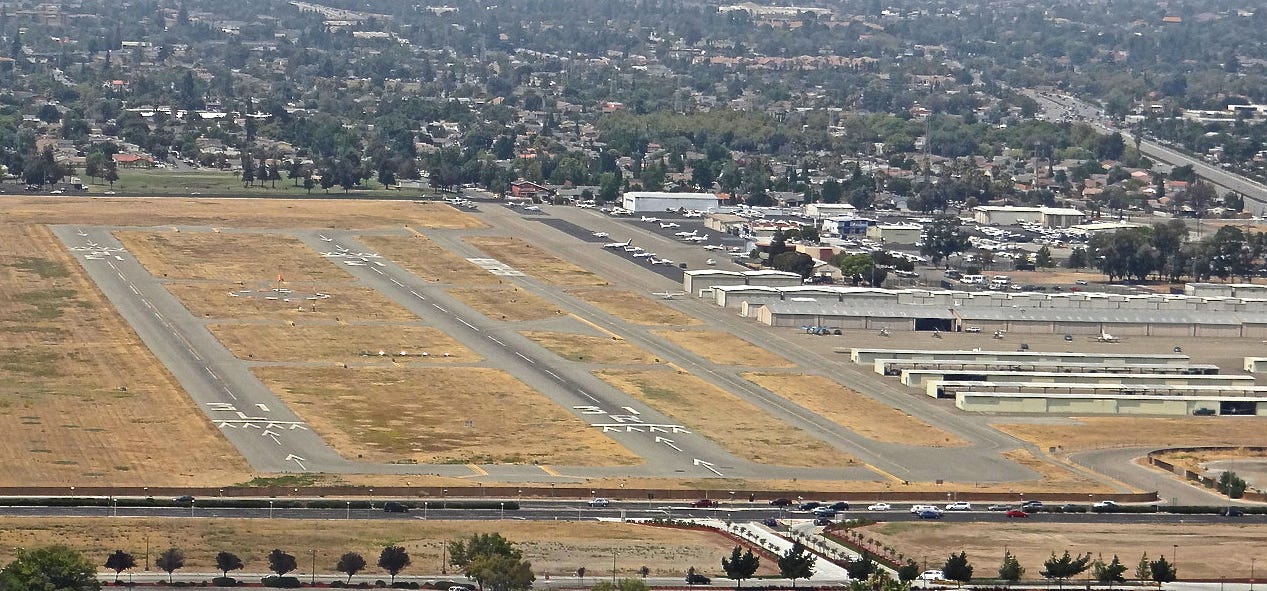
Particularly useful in the study was an unplanned twist: Its blood-test data from 2020, during the pandemic shutdown and while there was less flight activity at the airport, found that blood-lead levels of children living close to the airport dropped. The study also compared atmospheric lead levels at the airport with children’s blood-lead levels and found a direct correlation. (There have been no studies of lead in the air near Great Barrington’s airport.)
Other research showed that blood-lead levels in those under 18 within a wider circle, within 1.5 miles of the airport, to be comparable to the rest of California. And soil tests at the airport—much like those done in Great Barrington in 2017—did not show any elevated levels of lead. That’s meant a lot of back-and-forth in the debate over the results. But epidemiologists say the focus should be on the youngest children living closest to the airport; even a small amount of lead can harm developing brains and cause dramatic, lifelong impacts.
According to EPA and census data, in 2020 there were six children aged five or younger living full-time within a mile of the airport, and 40 who were 17 or younger. Within three miles of the airport, there were 154 children who were five years old or younger, and 888 who were 17 or younger.
Unleaded fuel at GBR
There have long been misunderstandings about which piston-engine planes can use the 94-octane unleaded avgas currently available at GBR. Put simply, it works just fine in about two-thirds of the piston-aircraft fleet in the United States. They are the ones, regardless of age, that have low-compression, and therefore less powerful, engines. Planes with more powerful high-compression engines need 100-octane fuel, which, for the moment, is only available with lead.
But while those more powerful aircraft make up only one-third of the general-aviation fleet, they consume about two-thirds of the 200 million gallons of avgas used each year.
Last September, the FAA finally certified the first “drop-in replacement” 100-octane unleaded avgas, which, pending a host of hurdles for refining, distribution, infrastructure, and transition planning, can be used by any piston-engine aircraft. Formulated by an Oklahoma company, General Aviation Modifications Inc. (GAMI), it was the result of a decade of work largely outside of slow-moving, still-unsuccessful industry and FAA efforts to produce 100-octane unleaded avgas. GAMI said it hopes to offer its fuel to some flight schools in 2024.
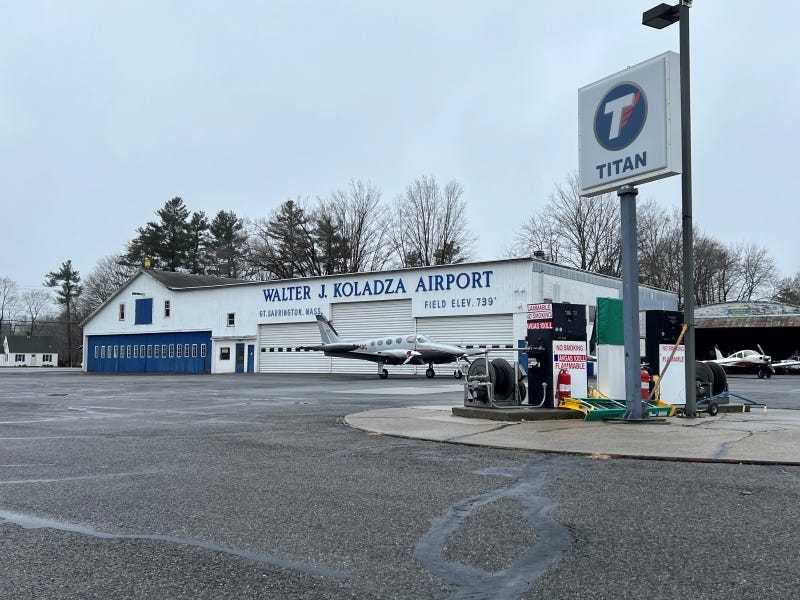
Today, most if not all of BAE’s flight-school aircraft can run on the 94UL unleaded fuel already sold at the Great Barrington Airport. Among its benefits—aside from zero lead emissions—are reduced maintenance costs, as lead can foul spark plugs and cause other engine problems. Given concerns about lead in the community, BAE had previously said it planned to switch its own planes to 94UL. Ken Krentsa, the airport’s former manager, announced in November 2017 that it was making the switch. “We’re going to use it in our planes,” he told the Berkshire Record. “I want it known that Berkshire Aviation is using unleaded fuel.” (Krentsa left BAE in 2018.)
Last week I asked Rick Solan if he’d consider using 94UL in all his flight-school aircraft. (According to a recent Argus analysis, in 2022 the flight school’s operations represented at least half of all flight operations at the airport.) He said he wouldn’t and pointed to increased cost.
Solan said that it would cost BAE an extra $2.00 per gallon to use the fuel, in part because of sizeable delivery fees from Indiana-based Swift Fuels, the only provider of 94UL. “The airplanes burn eight gallons an hour, so you’re talking sixteen bucks an hour,” he said. “I’ll just posit this: If your car takes this leaded gas, are you going to pay two bucks more a gallon [for unleaded] if you don’t have to? If I don’t have to, I’m not going to. And that’s just a business thing,” he said.
(The retail price of 94UL at the airport was listed at $5.30 per gallon on March 2, a dollar less than the airport’s leaded fuel, according to several avgas-price websites. Last summer it was nearly two dollars less per gallon than the cost of the airport’s leaded fuel.)
Solan said he’s confident the price of unleaded fuel will come down as more unleaded options become available. And he still thinks he’ll be able to get 100-octane unleaded in a year—despite broad consensus that it’s likely to take longer to be widely available. “So maybe just another year before we are totally unleaded,” he said. “What’s another year of burning leaded fuel in airplanes [here]? Versus 100 years of burning fuel with lead in it?”

Solan told me previously that because of those Swift Fuels’ per-delivery fees, he tries to reserve unleaded fuel in the UST’s 8,000-gallon 94UL compartment for pilots who specifically fly in for it. Indeed, last September, while spending a weekend day at the airport, I spoke to three pilots who keep their planes in Poughkeepsie, N.Y., and stop in at GBR on nice-weather weekends. They told me they love the old-time feel of the place, like to grab a take-out meal in town to enjoy back at the airport, and are glad they can top off the gas tanks of their Aviat Husky backcountry planes with 94UL before heading back into the skies.
What BAE tells town boards about lead
Egan, the airport’s attorney, has said repeatedly that concerns about lead are overblown. “It’s a scare tactic at its root,” he told the Planning Board in January. “All we can point to is that the airport is a good [environmental] steward and is one of the [few] airports that offer lead-free aviation fuel.”
At that same Planning Board meeting, Solan mischaracterized progress on achieving that eagerly awaited lead-free aviation future. “The federal government passed a law that in 2025 there can be no more lead in aviation gas. They just passed it through Congress and the Senate last year,” he said, incorrectly. “And it will be available after 2025.” As Solan spoke, Egan nodded.

But no such law was passed. Solan was perhaps confusing the FAA’s certification of GAMI’s unleaded 100-octane fuel and the hope that the company will soon find a refining partner to manufacture and distribute it nationally. The latest government-industry collaboration has set a goal of 2030.
As with many other aviation-related subjects that have come before town boards since 2017, without a consultant or independent expert to advise them, many volunteer boards don’t have the knowledge or expertise to evaluate some testimony. In this case, after hearing that information, the board simply moved on.
These issues came up again at that little-noticed but important Board of Health meeting on February 9. Pediatrician Ruby Chang, one of three board members, described at length her concerns about lead in air, soil, and water. “I’m not convinced that having an airport so close to where people reside and where there are children in schools is such a great idea,” she said during a conversation with Egan. “What we know now [about lead] is not what we used to, when the airport was initially established [in 1931].” She also brought up the aquifer. “We only have so much drinking water supply around us. And we need to be ferociously protecting what we have,” she said.
Chang also raised the danger from airborne lead. “Abutting the airport, in the flight path, is a school,” she told Egan, referring to the Berkshire Waldorf School on West Plain Road. Located just past the airport’s northern boundary. The school sits directly underneath a flight pattern used by aircraft landing on Runway 11 from the west. “I feel it’s the duty of an airport to make sure it doesn’t contaminate the people around it,” Chang told Egan.
Then she asked for more information: “How about air quality? Do you measure the amount of lead that is spread in the air?” Egan responded, “I’m not a scientist, doctor, but my understanding is that lead poisoning is predominantly in soil. I don’t know of any way to test lead in the air.”
Egan told me in an email this week that if any environmental, public health, or occupational safety agency requested additional testing, the airport would comply. “We would be more than willing to accommodate [that request],” he said. “They have not done so, and we believe they have not done so because they see no evidence indicating that such testing is necessary.”
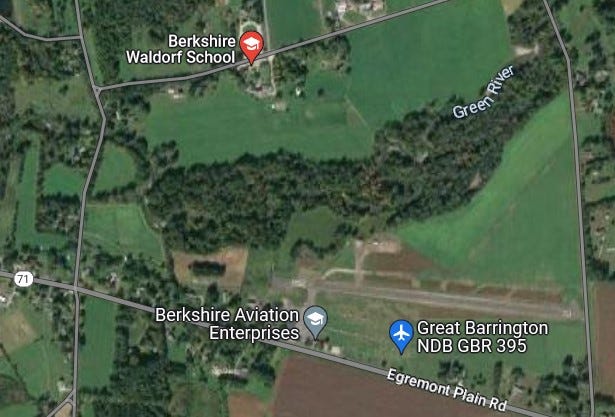
When I spoke recently to Erik Bruun, a longtime Berkshire Waldorf School board-of-trustees member and currently its board chair, he told me the airport “has always been a good neighbor.” (All three of Bruun’s children attended the school.) Though he said the early pandemic years made the airport more noticeable. “It became more present in the life of the school during the pandemic because we had a lot of outdoor classes,” he said. There was increased awareness of noise from aircraft, but Bruun said it wasn’t significant. “On the scale of [pandemic] inconveniences the noise was pretty low.”
This week Bruun told me the school has formed “a small working task force” to investigate whether it should be concerned about the airport’s operations. “To better understand the potential threat of lead from the exhaust of nearby airplanes, we are seeking the advice of consultants specializing in lead pollution to analyze our situation and consider testing options,” he said in an emailed statement.
Bruun said the impetus was a 2017 Michigan study that found higher blood-lead levels in children living near 448 airports in Michigan where piston aircraft operate. It was conducted by the same researcher, Colorado State University Professor Sammy Zahran, whose peer-reviewed study of blood-lead levels near Reid-Hillview Municipal Airport was the basis for that community’s ban on the sale of leaded avgas.
Bruun suggested there may be some mitigating factors here versus what was found in Michigan, including “prevailing winds, the volume of air traffic, seasonality and the uncertain impacts that airports located in industrialized areas might have had on the results of the study,” he said. (The authors of the Michigan study authors say they controlled for lead paint in old housing stock and for nearby industrial facilities that emit lead pollution.)
The Berkshire Waldorf School draws water from a well on its property. Because of the total number of adults and children it serves, it’s regulated as a public-water supply. “There has never been an indication of elevated levels of lead in the water tests that the school undertakes,” Bruun told me in a follow-up email.
There is no backup water
Its widely known that the Great Barrington Fire District, serving more than half the town, has no permanent backup water source. The open reservoir on East Mountain could be used in an emergency, Marks, the superintendent, told me. That would provide at least some low-pressure water for flushing toilets and minimal fire protection. And there are agreements to establish temporary connections to Housatonic Water Works and a public water system in Egremont, he said, as well as plans for bulk-water deliveries to the two water-storage tanks.
For decades, the fire district has sought that elusive second water source. It’s been slim pickings. To meet strict water-protection requirements, a drinking-water supply requires establishment of a protected area of 400 feet in any direction from the well. That means at least a dozen acres of land.
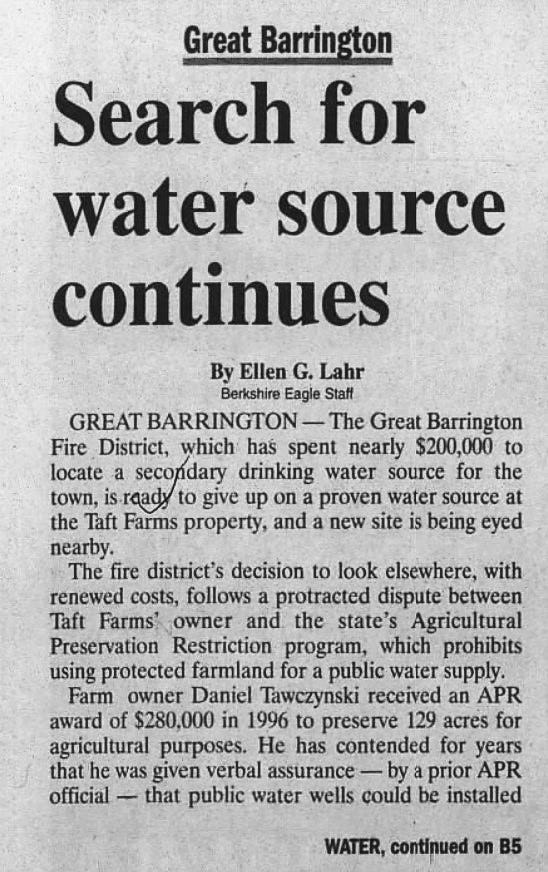
In 2005, they found a strong contender on property owned by Taft Farms, near the intersection of Division Street and Route 183. A test well produced 1,000 gallons a minute, according to news reports at the time. But the land there is in a permanent agricultural restriction; the state repeatedly blocked using it as a town water supply. Attempts by legislators and others to overcome that legal roadblock have all failed.
Marks told me about another test a few years ago that looked promising—for about 45 minutes. Then the pump filled with sand. He described other tests that found wells that would be superb for a single-family home but woefully inadequate for a public-water system.
As to the airport and any risk it might pose, Marks and the Prudential Committee he works for—a quasi-governmental elected board with taxing authority—both had no issues with the airport’s past hangar proposals, at least. Planes filled with fuel and oil and chemicals would be safer for the aquifer, they said, if garaged on concrete inside hangars than sitting outside atop the sandy, permeable soil that’s so good for recharging an aquifer.
In 2017, at the urging of the airport’s attorney, the Prudential Committee wrote a letter to the Selectboard making those same arguments. The letter also cheered the airport’s soon-to-be-abandoned plans to permanently end its 80-year run of underground fuel storage and move to an above-ground tank.
Still, Marks told me he sees no issues with the upgraded fiberglass, double-walled-and-alarmed—but still underground—avgas fuel tank. “It’s not like it was 30 or 40 years ago,” he told me as we drove down Hurlburt Road, the airport nearly visible to the west. “A tank could rot out and you could lose 10,000 gallons and nobody knew until they would come to get fuel and the thing’s empty. Now, if there’s a leak there’s an alarm. If there’s any unexplained change in level, there’s an alarm.”
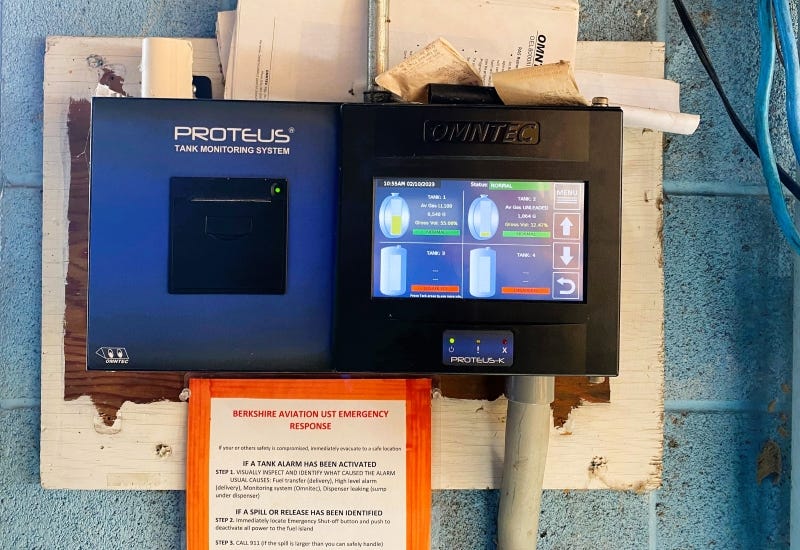
There is definitely an alarm: Joe Solan told me that the airport’s UST system has a leak alarm inside the maintenance hangar that’s so loud it can be heard outside even with the hangar doors closed. But the airport is not staffed all the time, and he said the system does not send text or email alerts—something the airport’s system can do by default if connected to the Internet.
Back at the infiltration gallery, Marks unlocked one of the just-above-ground access panels and opened a series of metal doors. “It would be hard to get the capability of what we can produce at the Green River [pumping station],” Marks told me, motioning toward the well. He described the impressive gallons-per-minute flow rate it achieves. Each of his pumps is rated at 600 gallons per minute; he can easily run all three to achieve 1,800 gallons per minute drawn from the aquifer. And sometimes more, he said.
Shivering in the January cold, I looked down into the infiltration gallery. Marks said that during 30 years working for the fire district, he can’t recall ever seeing the water level go down. Inside that concrete chamber, it pretty much stays at 11.5 feet, no matter the amount of water pumped or if there’s an extended dry spell. “Maybe it’ll get down to 11.4 feet,” he said.
That makes it an invaluable, likely irreplaceable resource.
NEXT: In part five, the full story of medical helicopter flights.
∎ ∎ ∎



